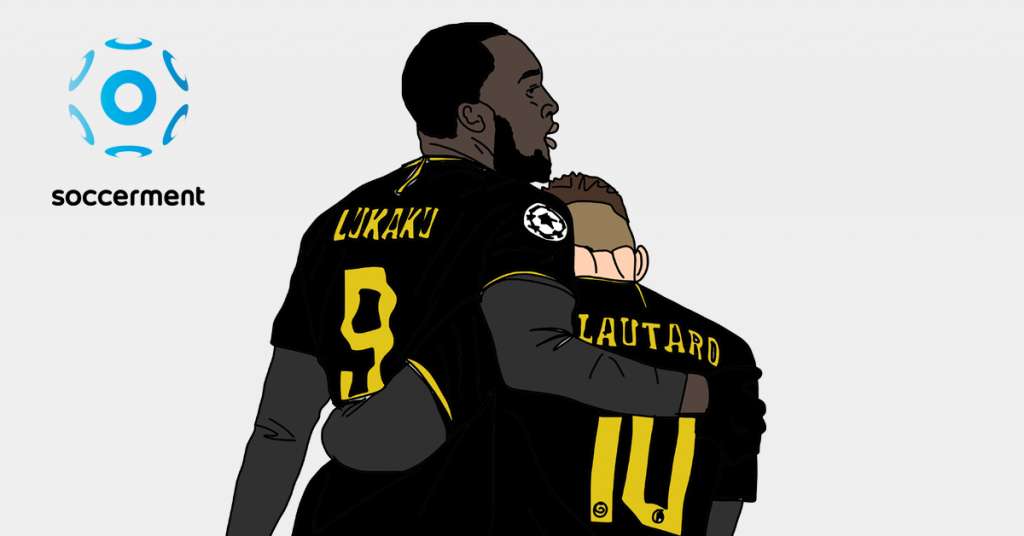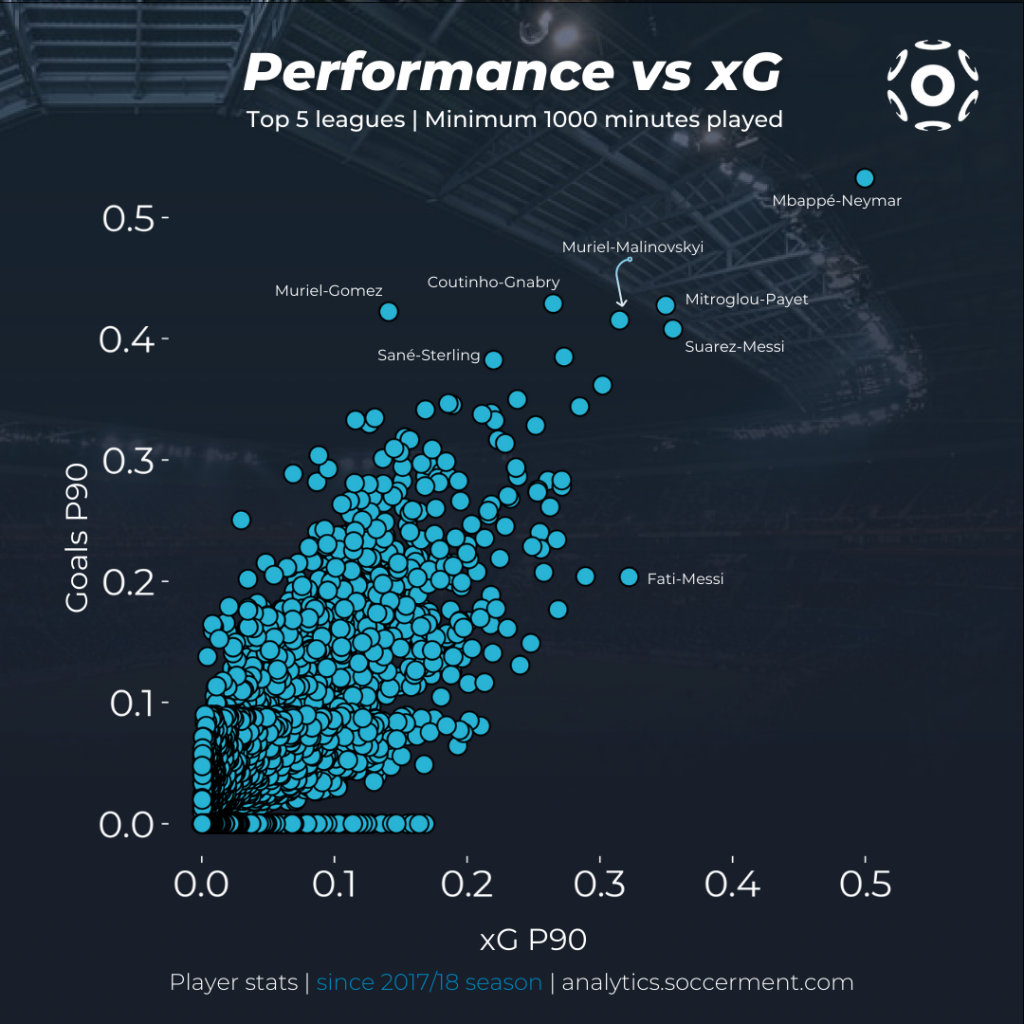For a forward, finding the right chemistry with a strike partner is a fundamental part of the game. It often makes the difference between a solid, reliable attack and a stagnant one. Sometimes, the synergies created by the partnerships are such that breaking them is really painful, for fans as well as for the coaches. Think of Messi and Suarez, Lukaku and Lautaro, Mbappé and Neymar, or Kane and Son: losing one of them doesn’t just mean losing a star player, it means losing synergies too. In this analysis we look into what attacking partnerships work together the best and pose the biggest threat to opponents. We also try to understand whether players’ complementarity positively influences the pairs’ offensive output.
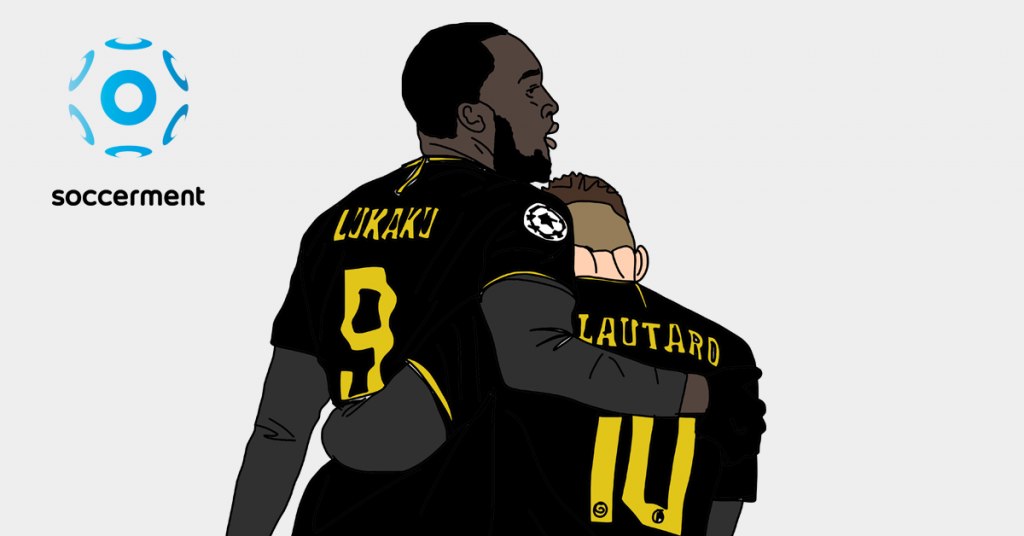
Introduction and methodology
Creating xG, together
In this report, we wanted to analyse the relationship and complementarity between attacking partners. Do the world’s most renowned strikers share their chances or do they just finish? Does having very different skillsets help or hinder a partnership’s attacking output? Which pairs are outperforming their Expected Goals the most?
Methodology: “Exchanged xG”
As part of our dataset, we analysed 16,240 different pairs of players who have produced at least one shot between them since the 2017/18 season. We have only used pairs who played in the top 5 leagues and have at least 1,000 minutes on the pitch together.
We also looked at the data for the past season (2020/21), reviewing 6,432 pairs of players from the top 5 leagues who played together for at least 900 minutes.
To measure the relationship between two players we have used so-called “exchanged xG”, which is essentially the Expected Goals produced exclusively by the two players forming the pair (a pass from player B that leads to a shot from player A and vice versa). The data regarding Expected Goals comes from our internal Expected Goals model.
For our comparisons, we have used exchanged xG on a per 90 minute basis.
In the next few days we will publish a post detailing all the internally developed advanced metrics, like Expected Goals, Expected Assists, xPass and a simple advanced metric with a funky name: “xOVA“. Watch this space!
So, who are the best pairs in Europe?
Who creates the most?
Crunching through our data, there were a couple of clear candidates for the title of “best pair in world football”. Perhaps to no-one’s surprise, such an award would probably be given to Kylian Mbappé and Neymar Jr. The PSG pair have created between them 19.7 xG, scoring 21 goals. Their style of play, characterised by Neymar’s superior technical skills, vision and dribbling, allied to Mbappé’s frightening speed, dribbling and finishing, make the pair extremely synergic on the pitch, leading to an impressive 0.50 xG P90 between just themselves (that is, excluding all other PSG players), which is significantly above the second-placed pair. This high-influx of chances has been transformed into 0.53 goals P90.
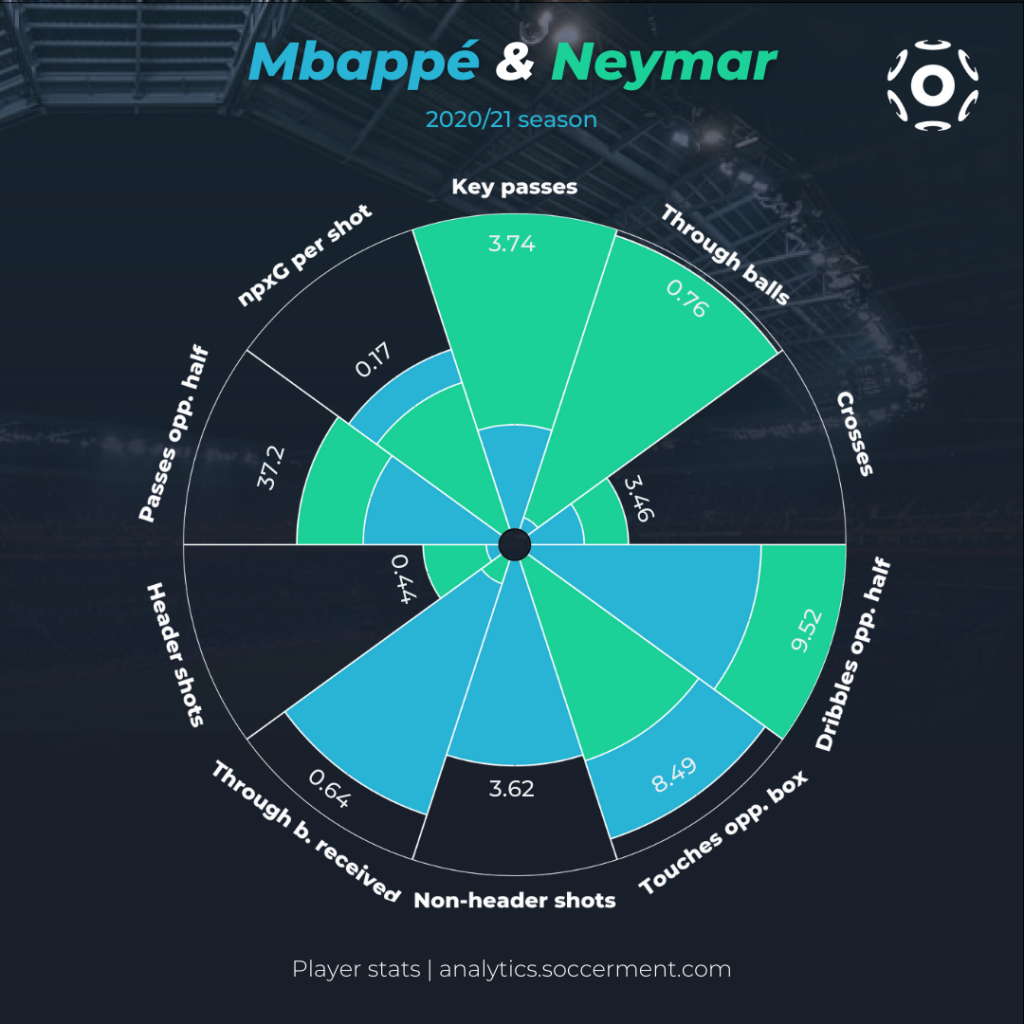
Lionel Messi and Luis Suárez have been considered one of the best attacking partnerships in world football for many years, fueled by their excellent chemistry on and off the pitch. This view is confirmed by the data, which reports an average of 0.36 xG P90 (only behind the PSG pair) that they have converted into 0.41 goals P90. These two best friends have the highest amount of total xG and goals produced as a pair (26.1 xG and 30 goals respectively) thanks to their successful partnership at Barcelona, which saw them work their magic together for several successful seasons. The Argentine also fares very well alongside wonderkid Ansu Fati, producing 0.32 xG P90 together.
To complete the podium, perhaps surprisingly, we have Kostas Mitroglou and Dimitri Payet. Unlike the other two pairs, who tended to share creating and finishing duties quite evenly, chance creation here is very one-sided: Payet has provided Mitroglou with 97% of the 4.1 xG produced as a pair. Their average of 0.35 xG P90 (converted into 0.43 goals P90) is extremely impressive, even if it has come from just over 1,000 minutes of play.
Luis Muriel and Ruslan Malinovskyi were one of the biggest surprises of the 2020/21 season. Not only have they produced a very high 0.32 xG P90 across their two seasons at Atalanta, but they have also consistently overperformed their xGs, with an average of 0.43 goals P90. Their partnership is definitely one to watch for the following season.
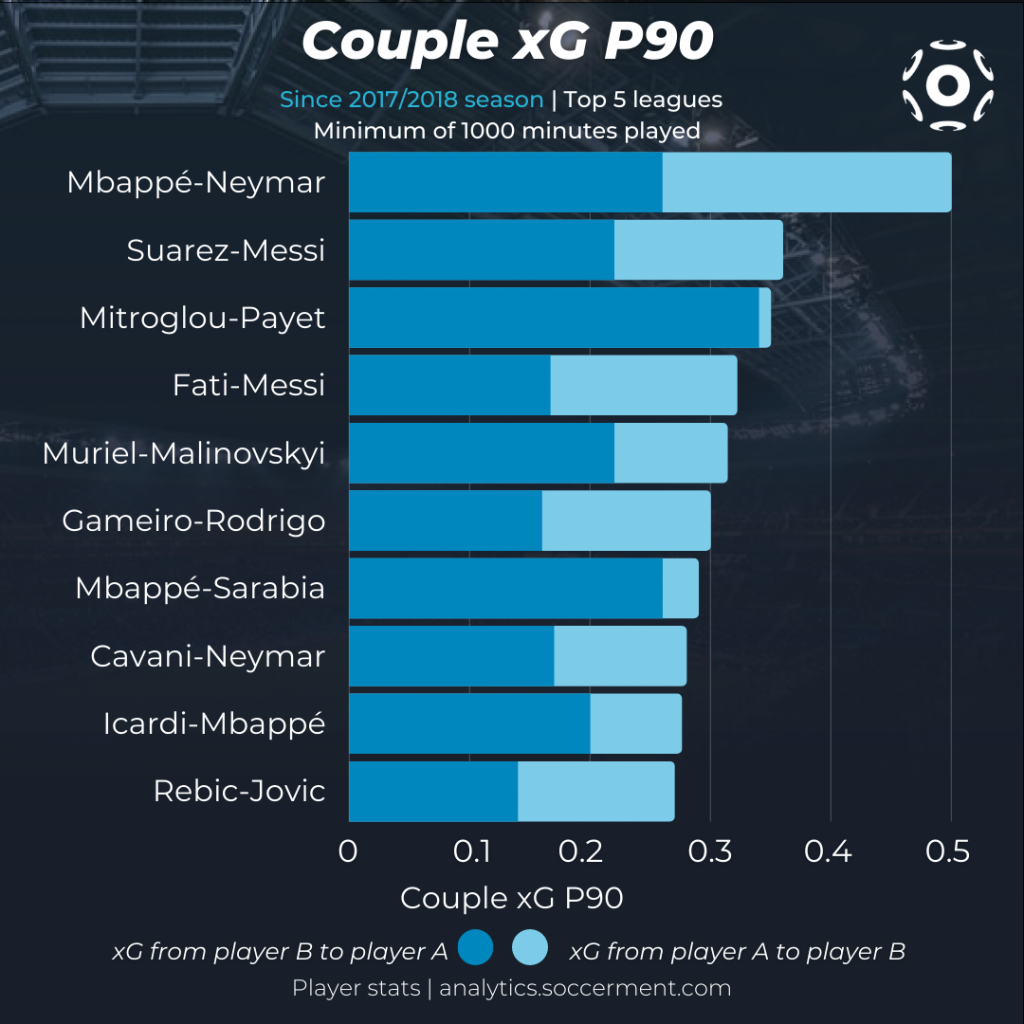
Who scores the most out of the pairs?
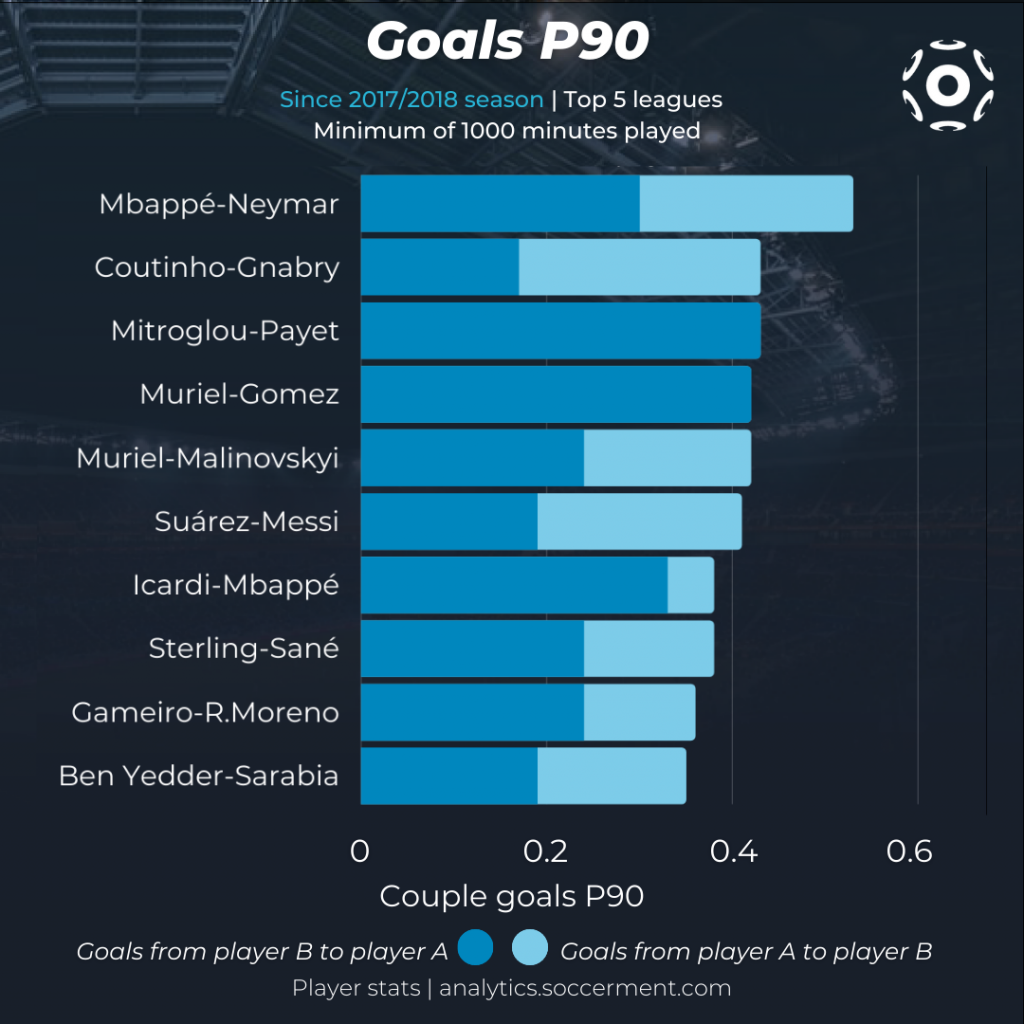
Out of all the pairs we have looked at, who are the most prolific? Once again, the duo of Mbappé and Neymar are the clear winners, thanks to 0.53 goals P90.
In second place, we have Coutinho and Gnabry, who at Bayern Munich scored 0.43 goals P90 as a pair. To complete the podium, we again have the duo of Mitroglou and Payet, who have also scored 0.43 goals P90 as a pair. Curiously, Muriel features in both the fourth and fifth placed pairs with 0.42 goals P90. He and Alejandro “Papu” Gomez, have scored triple the amount of goals as their exchanged xG (0.14), with Muriel and Malinovskyi rounding off the top 5 for produced xG. The Ukranian is fitting in increasingly well at Atalanta, providing a high influx of chances to the forwards, usually Zapata and Muriel, who all share good chemistry on the pitch.
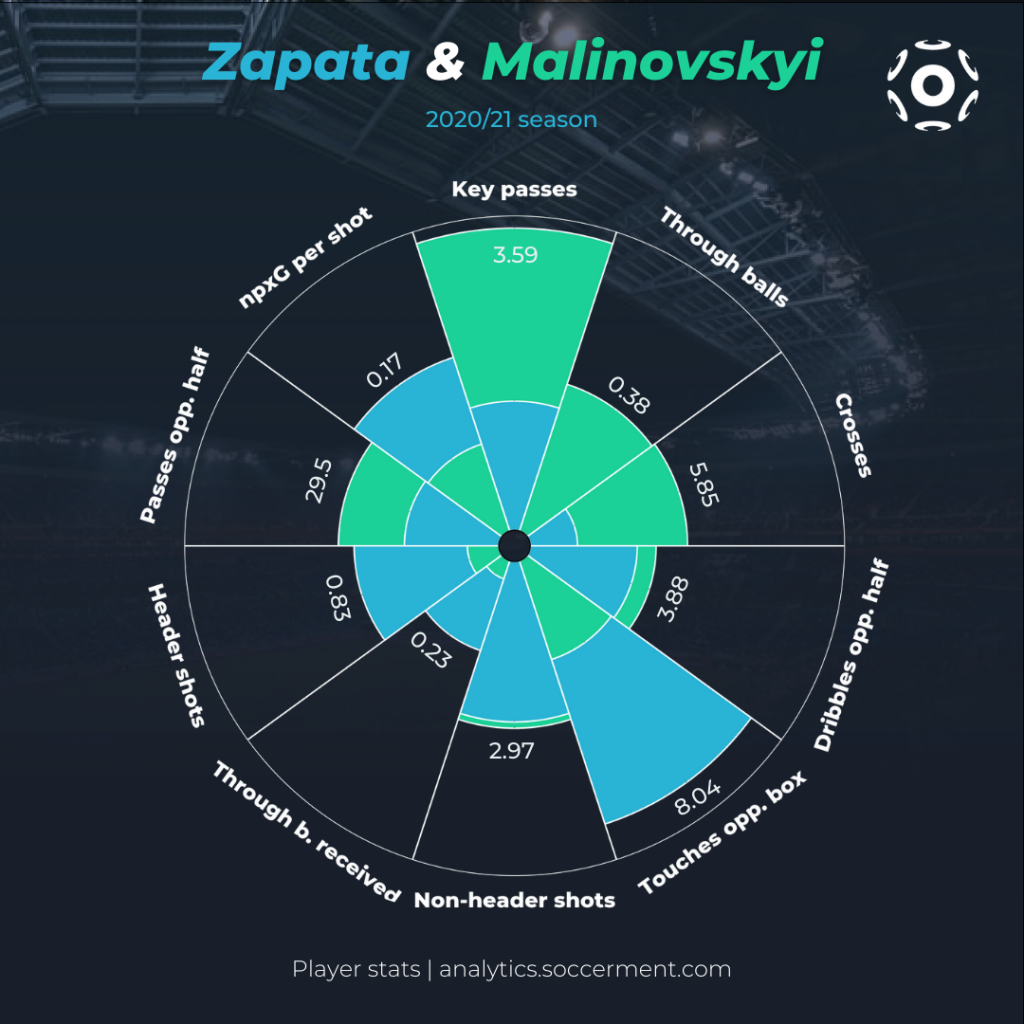
Performance vs xG
When evaluating player performance, it is important to observe the relationship between the goals scored by the pair and their relative xG. While players may consistently outperform or underperform Expected Goals, the two values tend to converge eventually. In this sense, a player could have an exceptional season with a very strong performance versus xG followed by a very poor season. For example, Timo Werner scored 28 goals from 20.9 xG in 2019/20, while in the following season he managed just 6 from 12.6 xG.
In the scatter plot below, we have captured the most significant duos for both xG production and outperformance of xG. While PSG’s star duo are in a league of their own when it comes to exchanged xGs P90 (0.50) and goals scored P90 (0.53), their performance versus xG is in line with the average (Mbappé tends to outperform while Neymar tends to underperform). Meanwhile, the legendary partnership between Suarez and Messi also produced and scored a high number of chances: 0.36 xG P90 and 0.41 goals scored P90.
But the greatest pair at outperforming their xG was the one formed by Muriel and Gomez (0.42 goals P90 versus 0.14 xG P90), such an amazing outperformance of 0.28 xGs P90, or 300%, is nearly impossible to sustain in the long term – particularly now that Gomez is in Seville! But Muriel’s incredible 2020/21 season demonstrated that there is a certain chemistry between himself and Malinovskyi, both regular outperformers of expected goals.
Next is a trio of duos who have managed to score an impressive number of goals in spite of low xG production, which will make it extremely difficult to sustain such outperformance in the long term. These pairs are Giacomo Bonaventura-Fabio Borini (0.25 goals P90 from just 0.03 xG P90), Arnaud Nordin-Romain Hamouma (0.29 goals from 0.07 xG P90) and Benito Raman-Rauwen Hennings (0.33 goals from 0.12 xG P90). Andreas Cornelius-Dejan Kulusevski complete the top 5 with 0.30 goals from 0.09 xG P90.
Some of the standout partnerships include that formed by Federico Chiesa and Franck Ribery when they were at Fiorentina with a total of 0.33 goals P90 from 0.13 xG P90. Edinson Cavani features a couple of times among the top partnerships thanks to his season with Manchester United, having scored 0.33 goals P90 from just 0.13 xG with Marcus Rashford, while he and Bruno Fernandes create 0.12 xG from which they’ve scored 0.28 goals P90. The duo of Philippe Coutinho and Serge Gnabry is the second highest scoring pair in the dataset on a P90 basis (0.43 goals P90 from 0.26 xG P90), and is also as one of the most overperforming.
Exchanged xGs underperformers
After a very promising start to the season, the partnership between Ansu Fati and Messi was one of the most productive in terms of exchanged xGs (0.32 P90), however, the pair only managed 0.20 goals P90. What a pity that they will not now get the chance to turn this around!
Robert Lewandowski surprisingly makes two appearances in the top-five underperforming partnerships: the first one sees him pair up with Bayern legend Arjen Robben in his final two seasons at the club, they managed a remarkable 0 goals P90 from 3.0 xG (0.16 xG P90). Meanwhile, in the treble-winning 2019/20 season Lewandowski and Ivan Perisic created 0.16 xG P90 without being able to score a single goal between the pair of them.
The most underperforming due on a P90 basis was Rodrigo Moreno and Denis Cheryshev at Valencia, who were unable to find the back of the net together from 0.17 xG P90. Cagliari’s Alberto Cerri and João Pedro were the second worst underperformers, failing to score together from 0.16 xG P90. João Félix and Álvaro Morata at Atletico Madrid were also worthy of mention (0 goals from 0.15 xG P90)
The pair with the highest xG without finding the back of the net together is Cristiano Ronaldo and Federico Bernardeschi (4.47 xG) at Juventus.
Player complementarity
Methodology
In order to assess which are the best strike duos and the ones that best work together we created a ‘Complementarity Index‘. Our goal was to quantify how much two players improve each other when evaluated together on a range of stats measuring their offensive output, namely:
- key passes (i.e. passes resulting in shots, including goal assists, often referred to as “chances created”);
- attempted through balls;
- attempted crosses;
- attempted dribbles in the opposition half;
- touches in the opposition box;
- passes in the opposition half;
- through balls received;
- headed shots;
- non-headed shots;
- average non-penalty xG.
These metrics allow us to single out different playing styles, and match, for example, a player with the vision needed to provide precise through balls with a fast runner able to attack the space; or a wide forward providing lots of crosses with an aerially dominant center forward. We restricted the analysis to forwards, since the complementarity between centre forwards and roles such as wingers and attacking midfielders is self-explanatory. We note that this process was carried out considering all possible pairs, not just the ones that actually played and produced chances together and therefore appear in this report.
We chose a geometrical approach to calculate the Complementarity Index, based on the visualisation shown in our player comparison charts.
First, we rescaled the metrics to a maximum of 100, in order for them to all be on the same scale (we note that this step was performed considering all players, not only forwards). We then calculated the area of the slice occupied by each metric, and evaluate how much the partnership between the two players improves each of their metrics. We then averaged the two players’ improvements in each metric, weighting each player by their overall stats, i.e. the sum of all their metrics’ areas. Weighting is a necessary correction in order to avoid a bias towards pairs with a significant imbalance in overall strength. Next, we combined the values for metrics that are closely linked: through balls attempted with through balls received, crosses attempted with header shots, and key passes with non-header shots. Finally, we averaged these improvements across all the metrics, giving a stronger weight to the “linked” metrics. The resulting number was then rescaled to 100 to yield the Complementarity Index.
| Pairs | Complementarity index | xG P90 |
|---|---|---|
| Suarez-Messi | 72.3 | 0.36 |
| Andone-Pérez | 69.4 | 0.15 |
| Belfodil-Kramaric | 58.8 | 0.08 |
| C.Ronaldo-Morata | 57.6 | 0.13 |
| Milik-Mertens | 47.6 | 0.20 |
| Lapadula-Caprari | 47.1 | 0.12 |
| Mir-Sandro | 46.9 | 0.02 |
| Farias-Pavoletti | 44.9 | 0.04 |
| Santander-Palacio | 43.8 | 0.11 |
| De Jong-Munir | 43.7 | 0.08 |
The top 10 features some interesting names, but what about the overall distribution for Forwards? The results are shown in the scatter plot below:
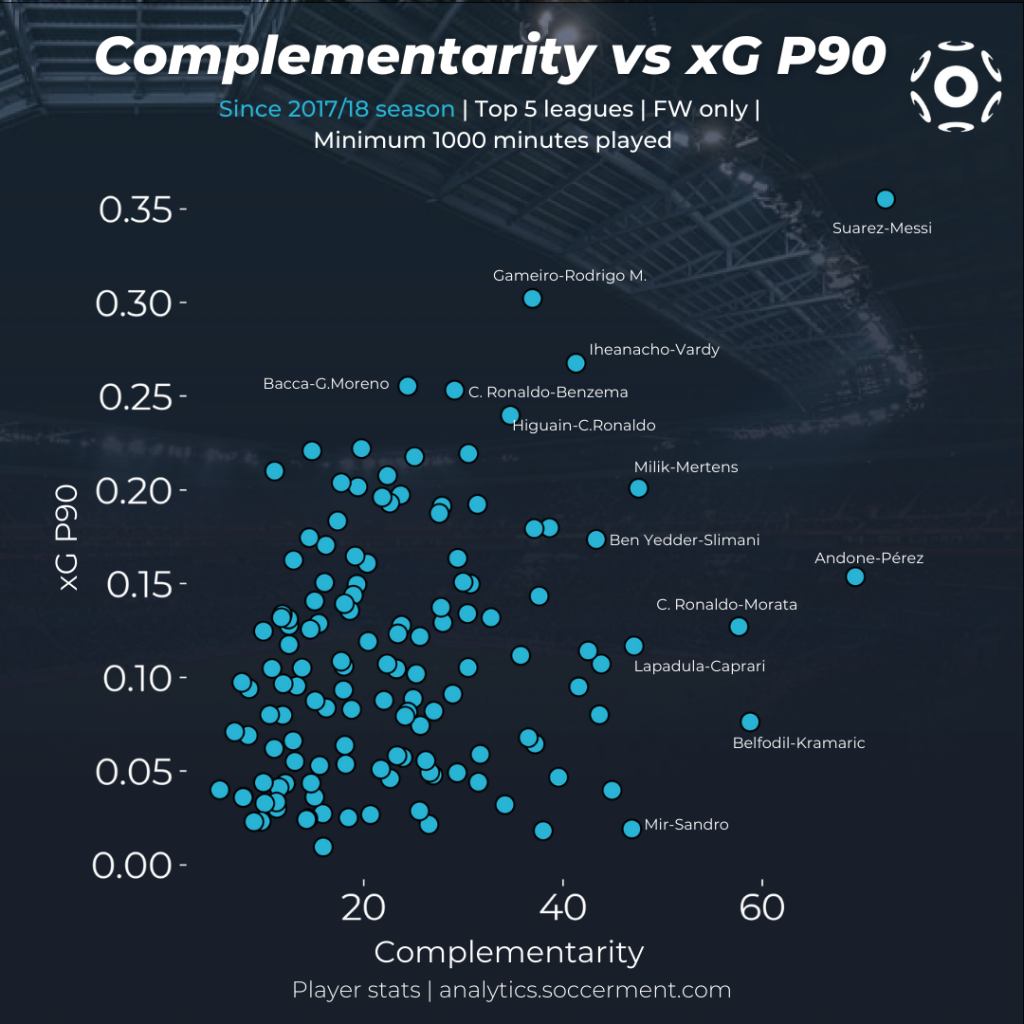
There seems to be no significant correlation between the complementarity of a pair and the amount of exchanged xG, at least as far as forwards are concerned.
Unidirectional chance creation
Not all pairs work in the same way. In fact, there is a lot of variability between strike duos as to how they create chances. While some pairs share the burden equally, in others it is very one-sided. So who are the players that contribute the most? As already mentioned, Payet created 97% of the 0.32 xG P90 in his partnership with Kostas Mitroglou. In the scatter plot below, we compare the distribution of goals in a pair (only forwards) and their complementarity to assess how common unidirectional chance creation is among the most complementary couples. A “couple balance” of 50% would mean the two players share their exchanged xG perfectly equally, while a low percentage means most of the xG came from shots of player A assisted by player B.
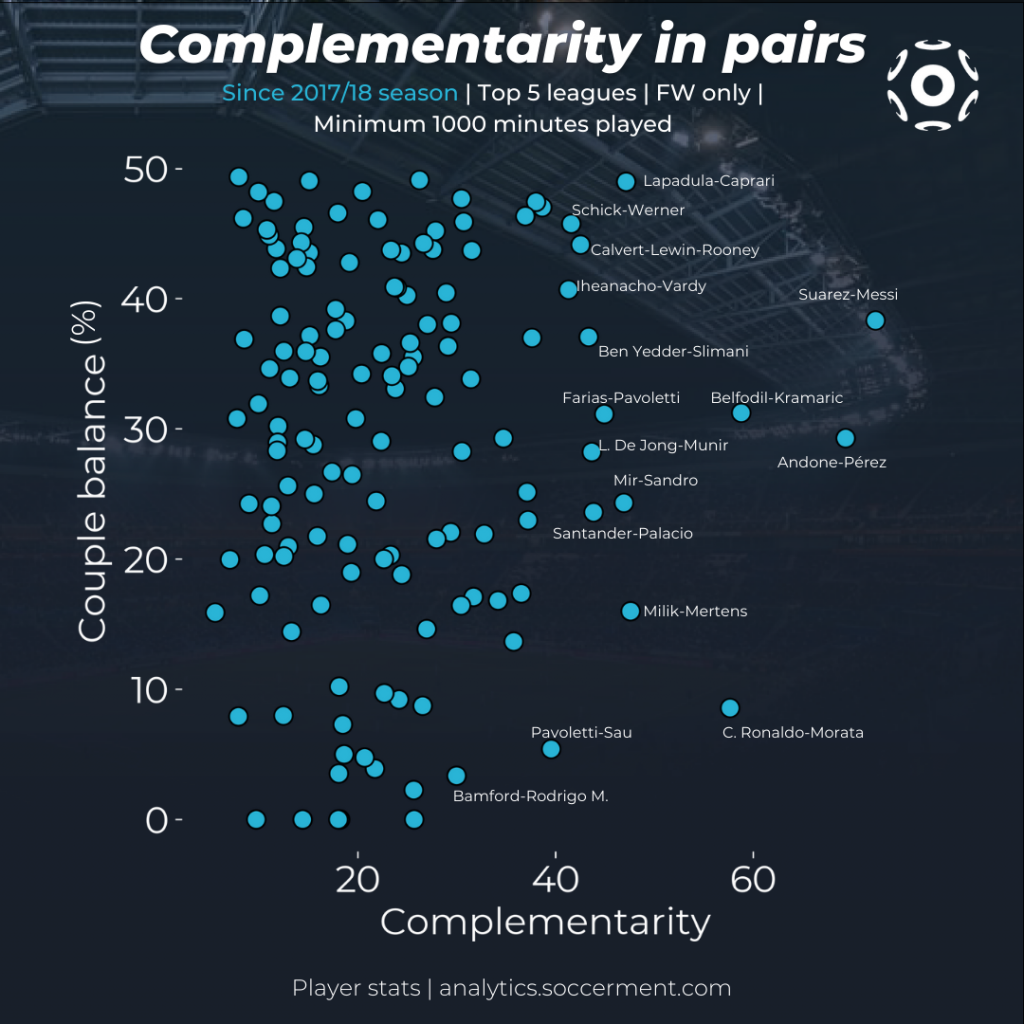
As can be seen in the graph, there seems to be no significant correlation between player complementarity and how evenly xG is distributed within the pair.
In the next graph, some of the most productive pairs of recent seasons can be found on the right hand side (those with higher total xGs). It is interesting to note the difference between certain duos. For example, Lewandowski appears in numerous partnerships who share a high amount of xGs but with low “couple balance”, something to be expected from a goal poacher like the Pole. On the other hand, Liverpool’s famed front three all appear among the best pairs by “couple balance”, highlighting the associative nature of their playing styles. Some of the most significant pairs with regards to “couple balance” are: Mbappé-Neymar, Laborde-Delort, Martinez-Lukaku and Kane-Son.

Pairs who are close to 50% tend to be the most synergic and associative.
Contribution to team’s xG
We evaluate the duos’ contributions to their respective teams by calculating total exchanged xG as a fraction of the total xG produced by the team when both players were on the pitch. As such, the pairs who have contributed the most to their team’s xG will feature in the upper part of the graph. Which means that players featuring for very offensive teams which tend to create high volumes of chances will be less favoured than those who are fundamental parts of less dangerous teams.
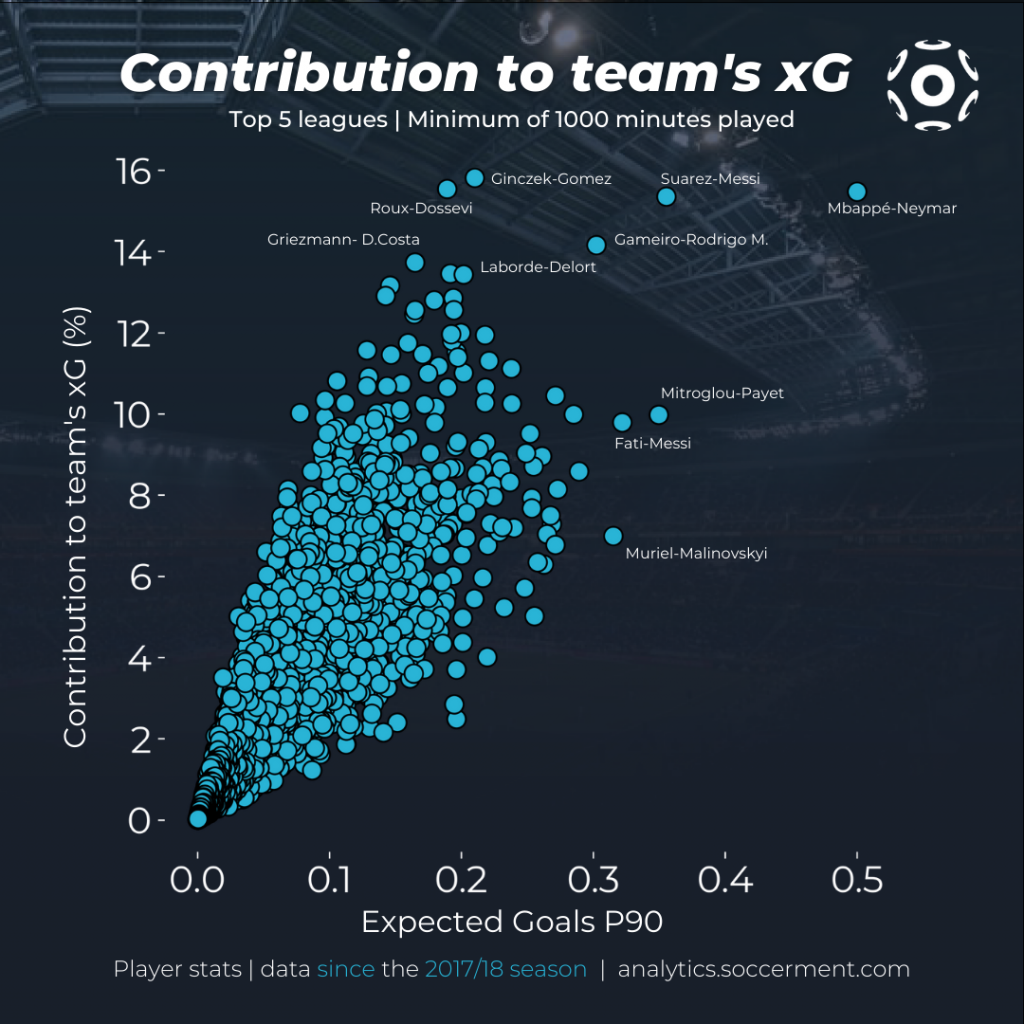
Mbappé and Neymar, who appear in the top right of the graph, clearly form the best partnership of the last four seasons. This duo created 0.5 xG P90 (much higher than the second-ranked duo) and is responsible for 15.5% of the team’s xG when both players were on the pitch.
It is worth noting that Messi enters the top 5 for strike duos xG twice, although these two partnerships contribute different weights towards the team’s xGs. The Suarez-Messi pair has an incredibly significant weight within the team (15.4% of total xG, the 4th highest value in the dataset), while Fati and Messi are responsible for 9.8% of Barcelona’s xG (which is a good result, if not particularly close to the top 10).
Mitroglou and Payet, who played together at Marseille, show data similar to Fati-Messi: 0.35 xG P90 and 10.0% of the team’s xG.
The ex-Atletico Madrid duo of Antoinne Griezmann-Diego Costa enters the top 10 with 13.7% of team xG. As the graph shows, this duo lies further to the left than the other top partnerships: with 0.16 xG P90 exchanged between each other, they were a prolific and well-matched duo who made the best of relatively few chances.
Of the pairs that are still together, Gaetan Laborde-Andy Delort is one of the best in both metrics: with 0.19 xG P90 and 13.5% of Montpellier’s xGs, this balanced duo are the cornerstone of their team’s attack.
Luis Muriel and Ruslan Malinovskyi, who played together in the last two seasons, are a peculiar case: they are fourth for duo xG P90 (0.32) but do not contribute a high percentage of Atalanta’s xG at just 7.0%, probably due to the team’s style of play and prolific nature, as well as their player rotation, which has intensified in recent seasons.
2020/21 review
In the 2020/21 season, several duos have demanded the spotlight for their remarkable contributions to their teams. Some of the most emblematic cases are Romelu Lukaku and Lautaro Martinez, Harry Kane and Heung-Min Son, and André Silva and Filip Kostic.
Contribution to team’s xG
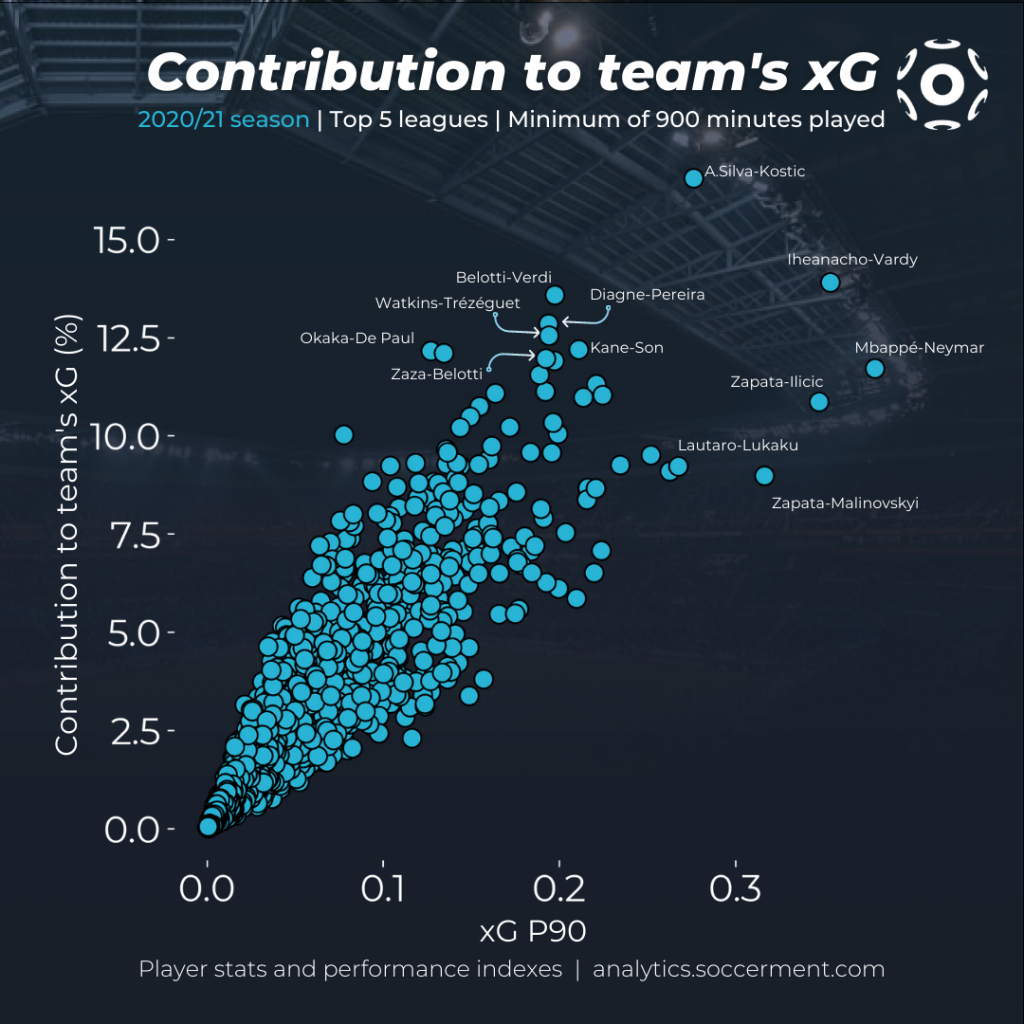
André Silva and Kostic are the clearest outliers in the graph. Eintracht Frankfurt’s duo is responsible for 16.6% of team xG (the highest in the top 5 European leagues) and were among the best strike partnerships in Europe in the 2020/21 season for xG production (0.26 xG P90).
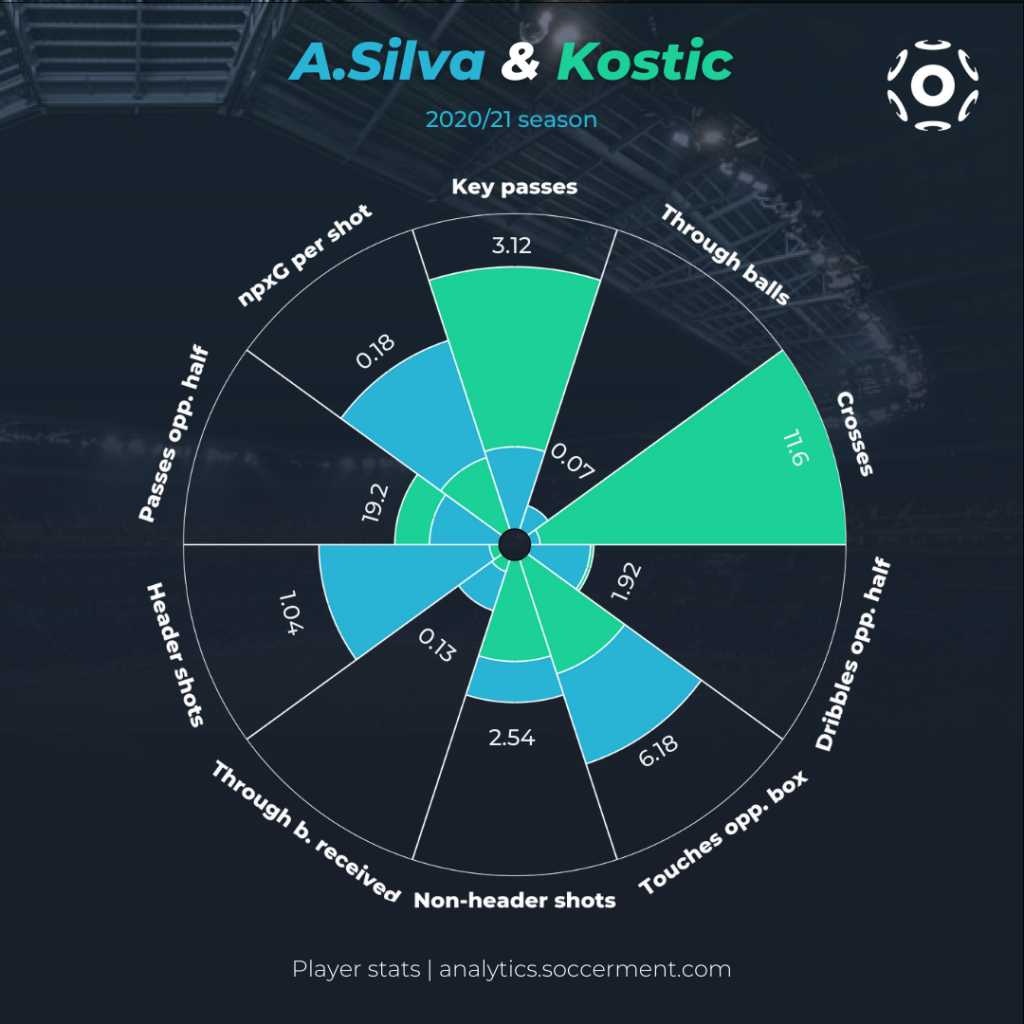
Kelechi Iheanacho and Jamie Vardy are second in terms of contribution to their team’s xG (13.9%); in addition, they also produced a striking number of exchanged xGs (0.33 xG P90). Leicester will be keen to see more of them together in the upcoming season.
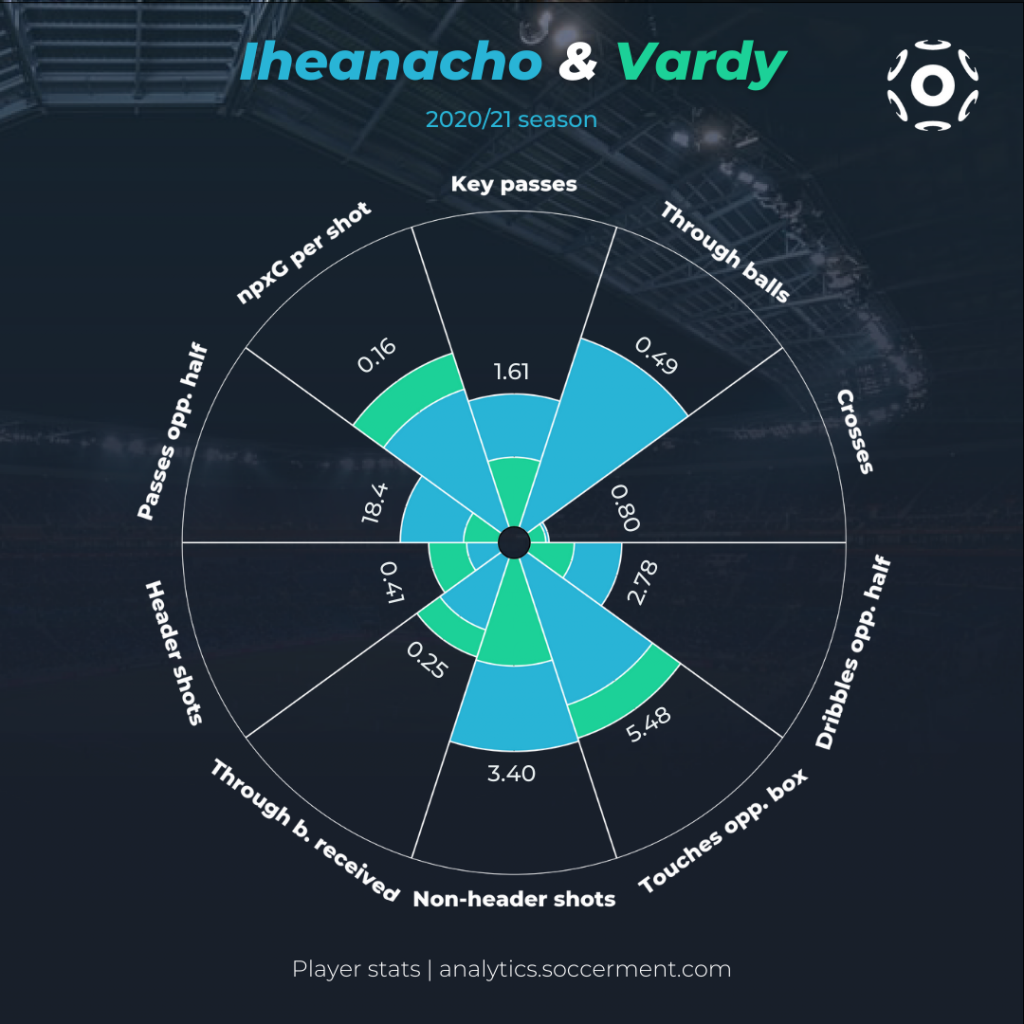
Torino enter the top 10 for relative xGs with two strike partnerships: Andrea Belotti-Simone Verdi (13.6%) and Simone Zaza-Belotti (11.9%). Both duos show reasonably good results in terms of partnership xG P90 (0.19 and 0.18 respectively), while the data highlights differences between the two duos in terms of distribution of chances among the two players: the first partnership seems very well balanced (0.09 xG P90 from Il Gallo to Verdi, 0.09 xG P90 from Verdi to Belotti), while the second partnership is almost unidirectional, with 89.9% of xGs going from Belotti to Zaza.
On the right side of the graph, we find three duos that appear in the top 5 for pair xG: Kylian Mbappé-Neymar, Duvan Zapata-Josep Ilicic, and Zapata-Roman Malinovskyi (0.35, 0.34 and 0.31 xG P90 respectively). In relative terms, these duos register good results (11.7%, 10.9% and 9.0% of their team xGs), and they are only held back from being even higher due to the fact that Pochettino’s PSG and Gasperini’s Atalanta tend to create an extremely high number of dangerous situations with a wide range of players. On the other hand, forwards from teams that generate a relatively low number of opportunities and that rely on contributions from their strikers, such as Torino, Udinese (Okaka-De Paul) and West Bromwich Albion (Diagne-M.Pereira), are more likely to perform well on this metric.
Top 10 for xG P90
1) Mbappé – Neymar
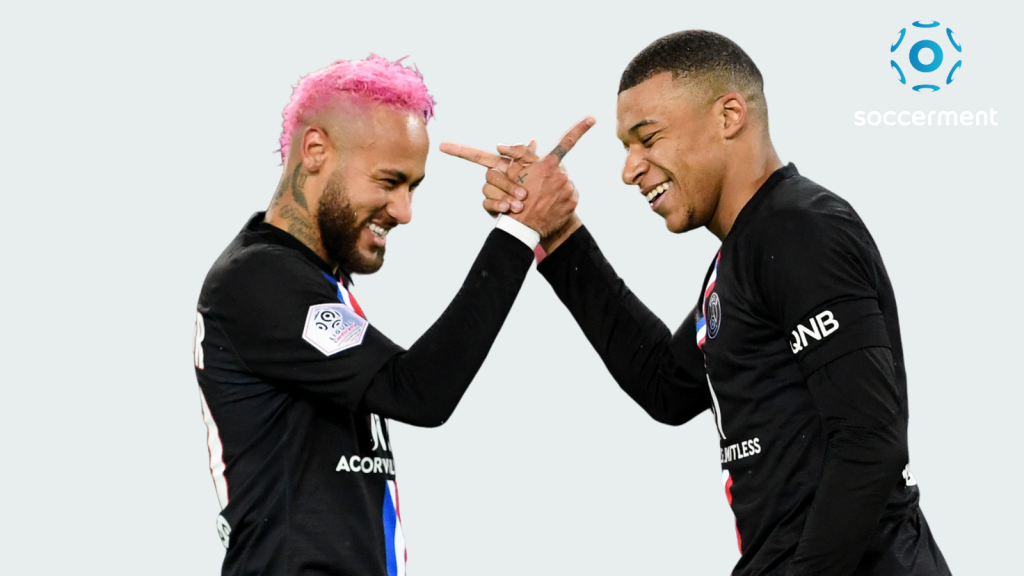
With 0.38 xG per 90 minutes (P90) exchanged between each other, Mbappé and Neymar are the best strike partnership in the top 5 leagues. Their relationship seems balanced, with 0.20 xG P90 going from O’Ney to Mbappé and 0.18 xG P90 going in the opposite direction. Their bi-directional relationship can be explained by the fact that they are two world-class players with a heterogeneous and complementary set of attributes. Neymar, with 6.0 successful dribbles P90 (5.5 in 2020/21, against an average of 1.6), is among the best dribblers in the world. In addition, he is equipped with outstanding vision, as evidenced by his 3.2 chances created P90 (3.8 in 2020/21, average 1.4). Mbappé’s speed, dexterity and finishing ability make him one of the most lethal forwards in the world, with a 20.4% goal conversion (21.1% in 2020/21, average of 9.7%) and an overperformance with respect to the xG metric of 114% (125% last season).
2) Iheanacho-Vardy
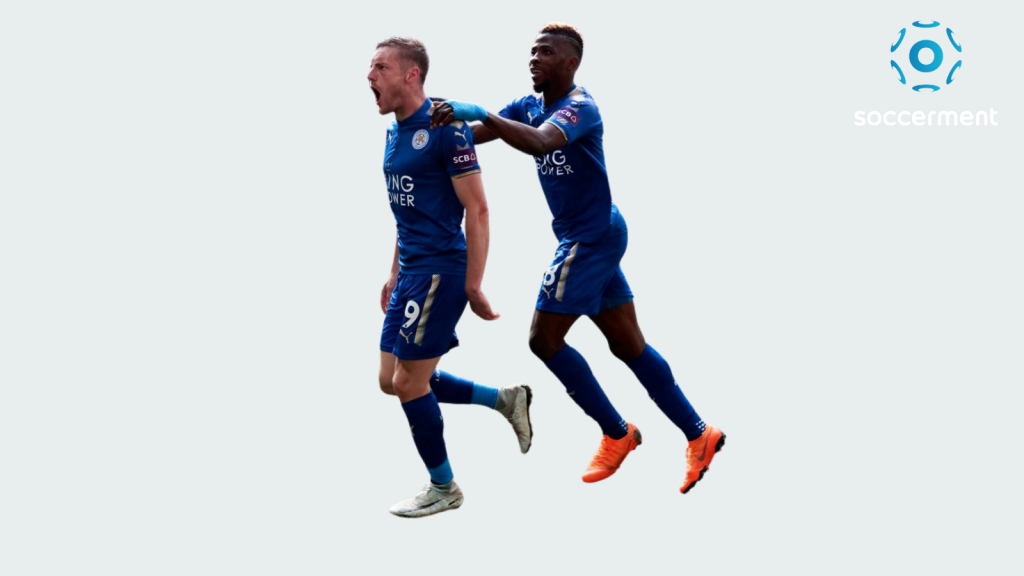
Leicester City’s duo, under the expert eye of Brendan Rodgers, produced 0.35 xG P90 (significantly higher than their 0.24 goals P90). They both created chances for each other, but xG is slightly higher from Vardy to Iheanacho (0.21) than vice versa (0.14). This could seem counterintuitive, considering Iheanacho’s high dribbling success ratio (66.0%; 72.7% in the last season) and ability to create chances (1.5 chances created P90, 1.7 last season), along with Vardy’s role as a poacher, with an above-average shot accuracy of 48.7% (46.3% in 2020/21). However, the data shows that Vardy uses his outstanding speed to create dangerous situations not only for himself, but for his teammates too.
3) Zapata-Ilicic
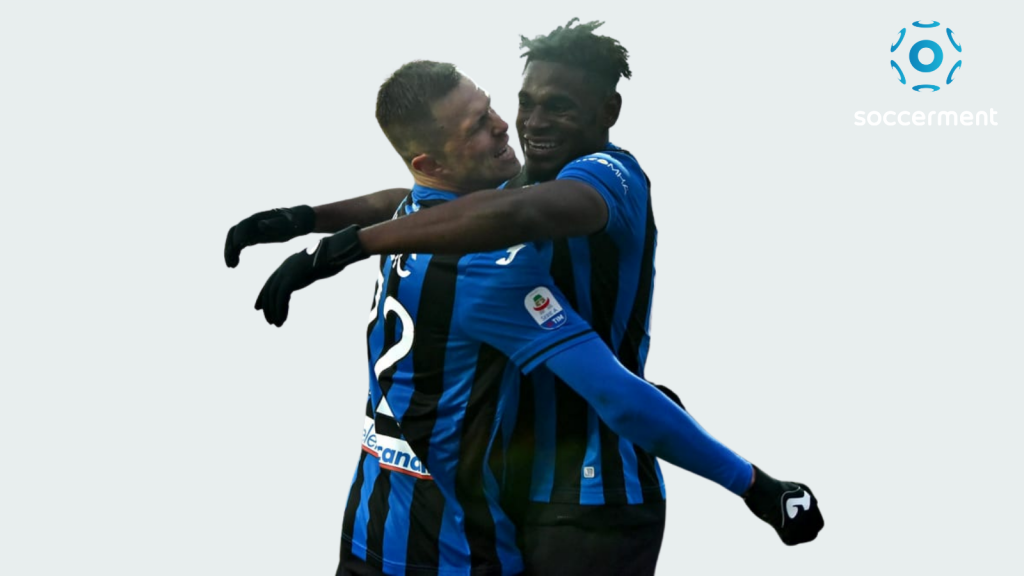
The Zapata-Ilicic duo is one of the most productive in Europe, with 0.35 xG P90 (0.18 goals P90) exchanged between them. Their partnership works because Ilicic is an outstanding creator (3.0 chances created P90, 3.6 in 2020/21) and a good dribbler (3.2 successful dribbles P90, 3.4 in 2020/21), while Zapata can be considered a complete forward, who tends to associate with teammates. Despite his weight he is quite fast and he likes to contribute to his team’s build-up, with 0.25 assists P90 (0.34 last season, average of 0.11). As could be expected given their characteristics, 0.31 xG P90 went from Ilicic to Zapata, far more than the other way around.
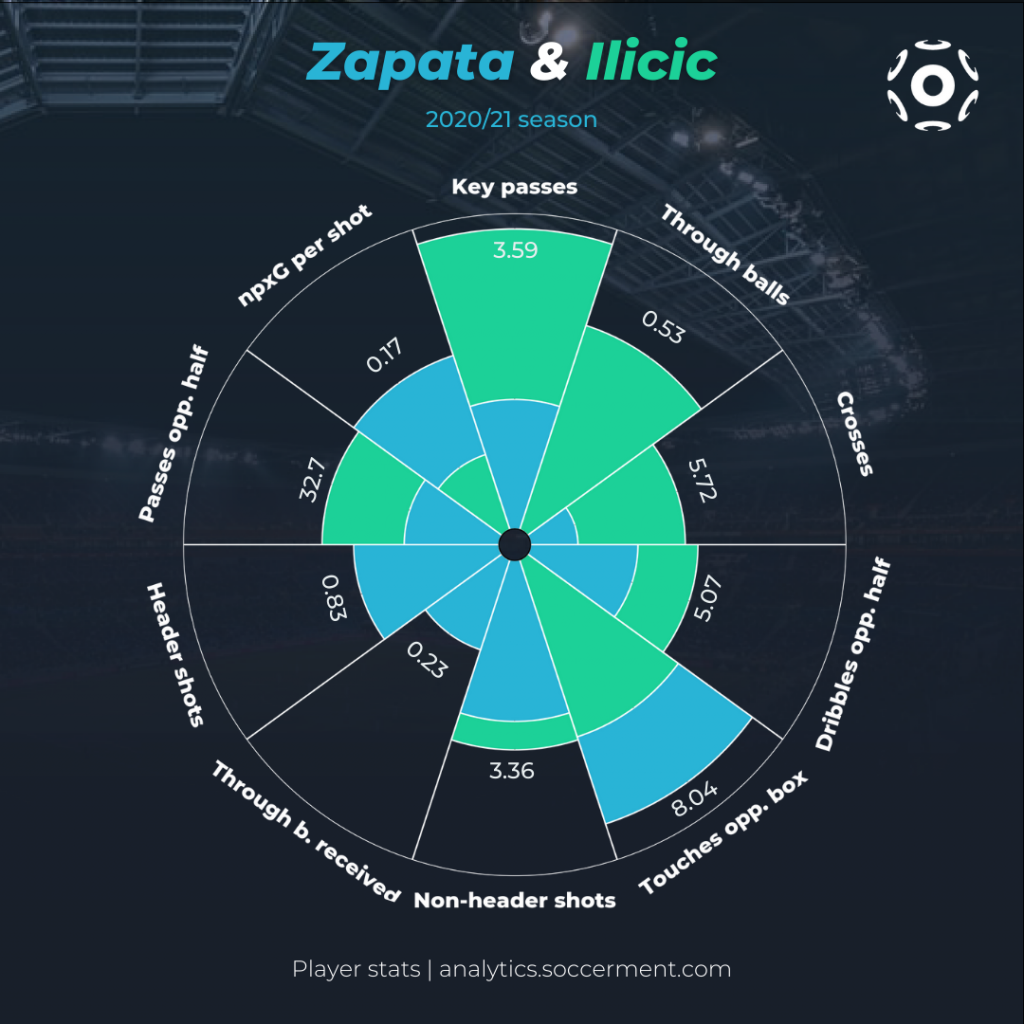
4) Zapata-Malinovskyi
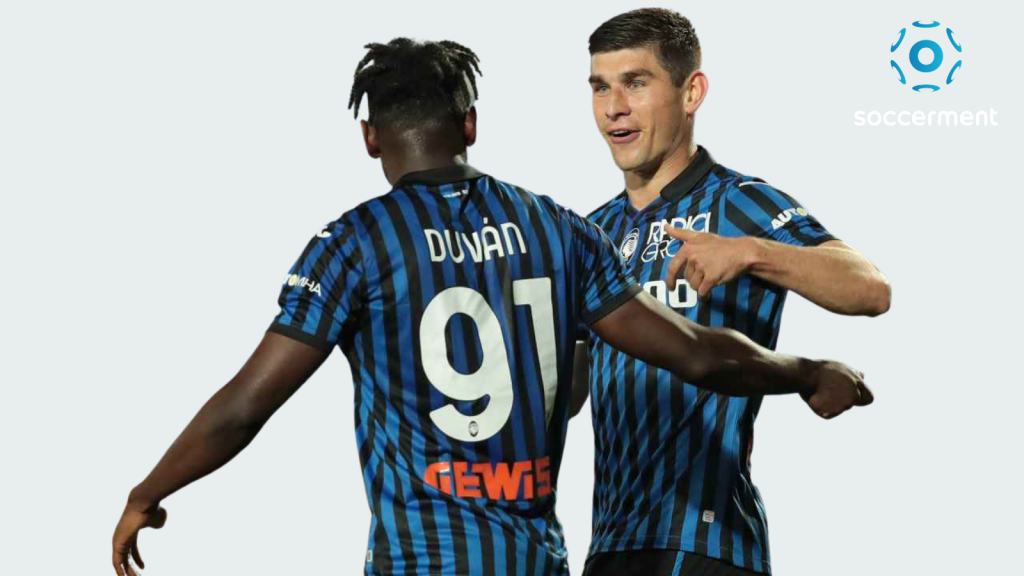
Gasperini’s Atalanta is a goal machine: this pair created 0.32 xG P90. The relationship between the two is unbalanced, with more chances (0.25 xG P90) going from Malinovskyi to Zapata. This imbalance can be partially explained by the fact that Malinovskyi is a strong set-piece taker. In addition, Malinovskyi is also an extremely technical player with 0.28 assists P90 (0.57 last season, against an average of 0.16); he frequently plays next to (or in place of) Ilicic. The pair also share good finishing abilities that enable them to overperform xG: they are the 3rd best pair in Europe in goals scored P90 (0.40 P90).
5) André Silva-Kostic
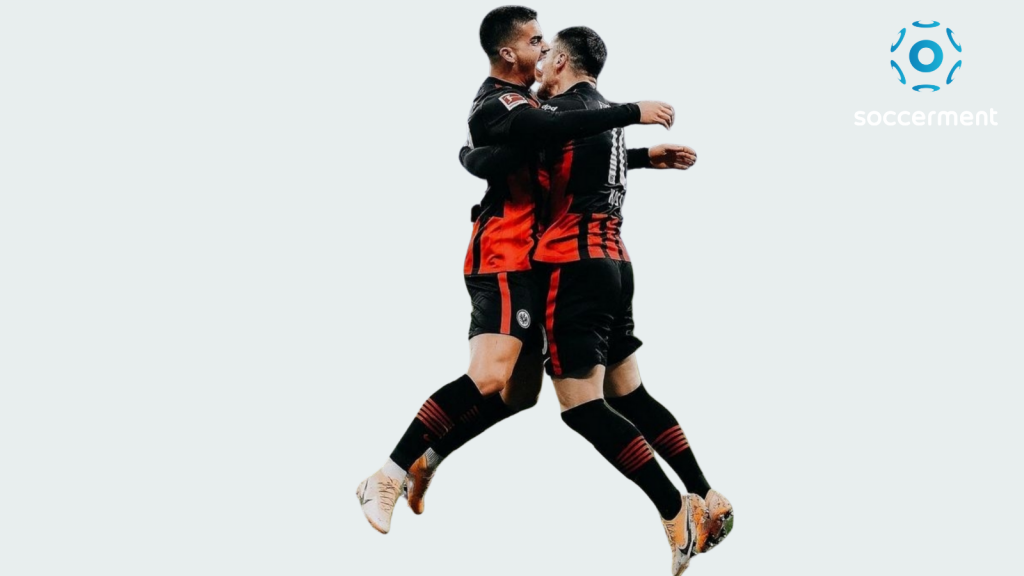
The Eintracht pair’s amazing season is evident from the xG P90 that they exchanged between each other, 0.28 xG P90. They outperformed the xG metric by 0.08 goals P90, resulting in 0.36 goals P90. The relationship between the two players is almost completely unidirectional: xGs usually flow from Kostic to André Silva (0.25 xG, or 92.2% of the total). This is not surprising: Kostic manages 1.4 successful crosses per match (2.0 in 2020/21, against an average of 0.3), while Silva is lethal in the box (8 headed goals in 2020/21, average of 3).
6) Lautaro-Lukaku
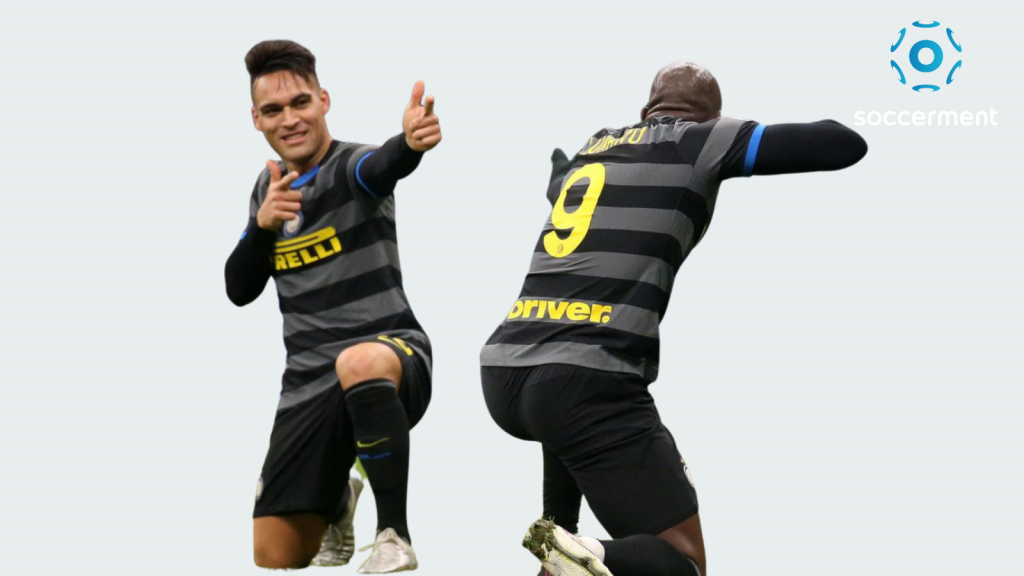
The duo that brought the Scudetto back to Milan created 0.27 xG P90 in 2020/21. It is interesting to note that they also outperformed xG, with 0.31 goals P90. The relationship between the two seems very well balanced: 0.14 xG P90 from Lukaku to Lautaro, 0.13 from Lautaro to Lukaku. Due to his physical strength (190cm and 94 kg), Big Rom is a target man who accentuates the characteristics of a second striker who gravitates around him. He is a clinical striker (19.2% conversion rate against an average of 13.5%) but also an excellent assister who creates 0.21 through balls P90 (0.19 in 2020/21, against an average of 0.09).
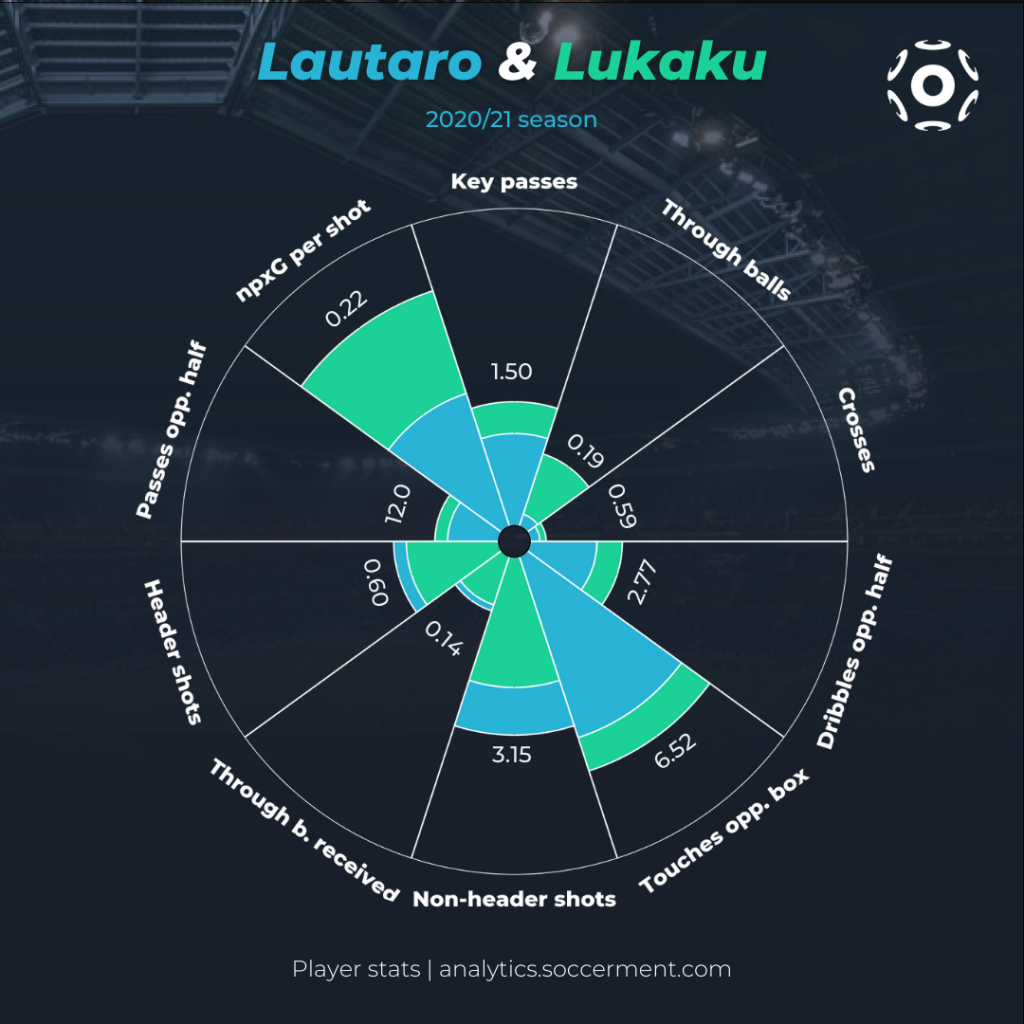
7) Mbappé-Di Maria
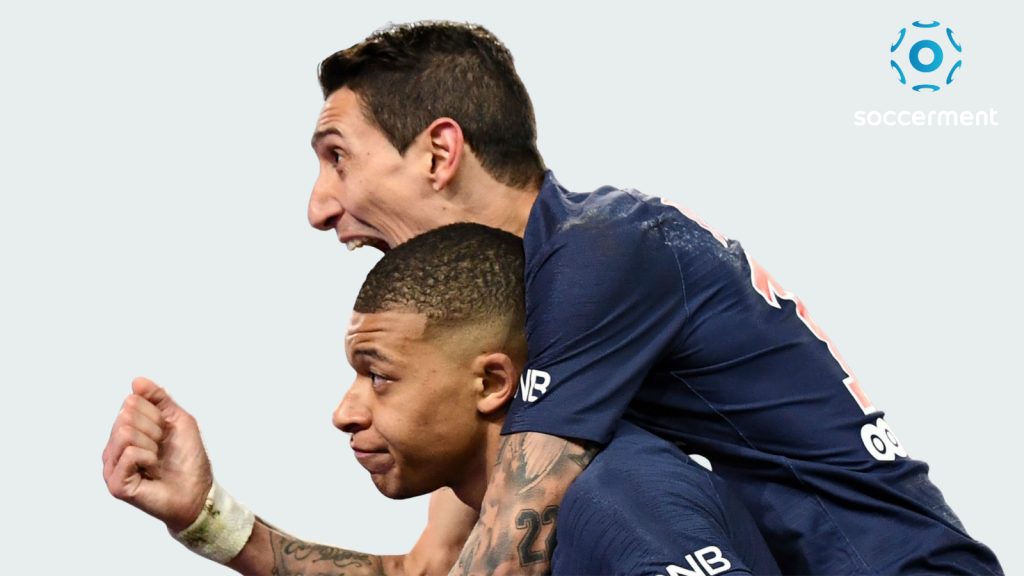
The second PSG duo on this list manage 0.26 xG P90. In contrast to the Neymar-Mbappé pair, the relationship is particularly unidirectional: 0.23 xG (87.1%) goes from Di Maria to Mbappé.
This outcome seems natural: Di Maria is a very creative winger who completes 1.03 through balls P90 (0.68 in 20/21, against an average of 0.12), an excellent way to release Mbappé and his speed behind the opposition’s defense.
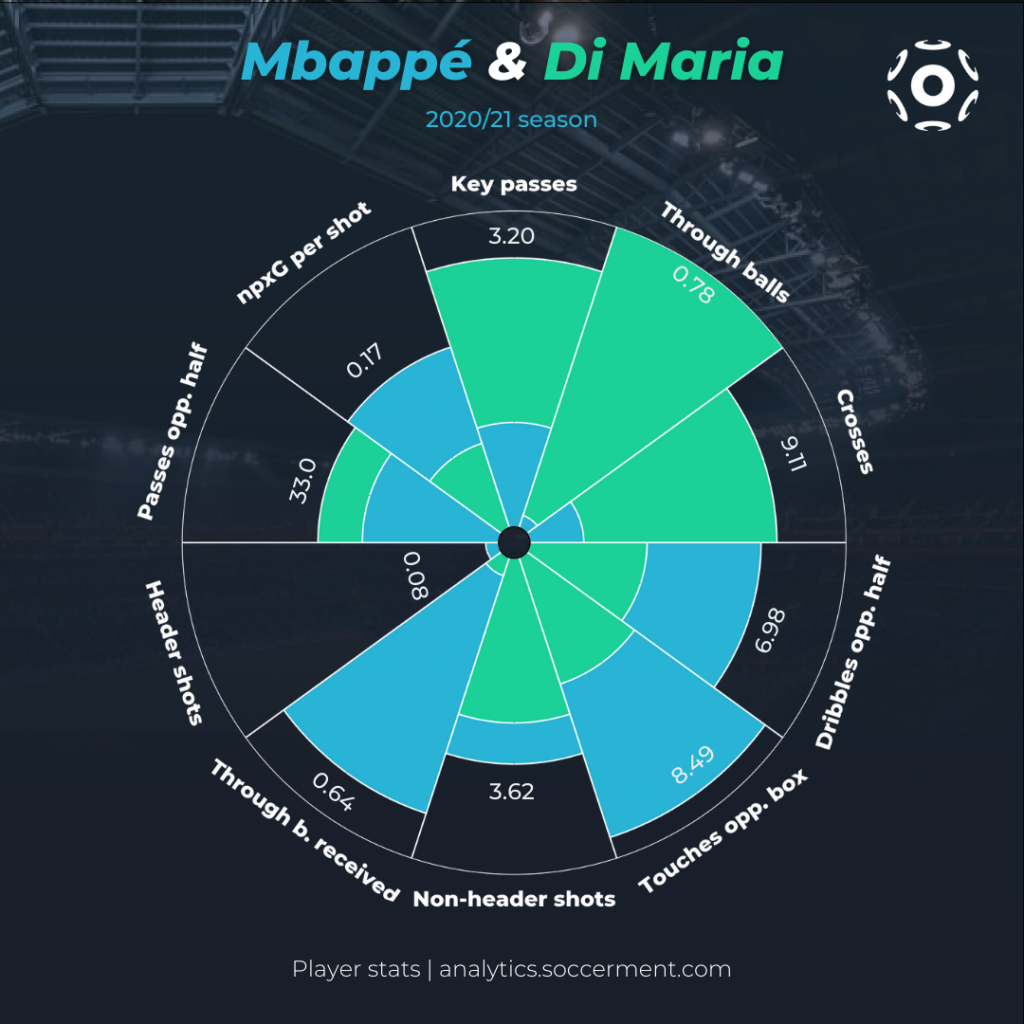
8) Morata-Chiesa
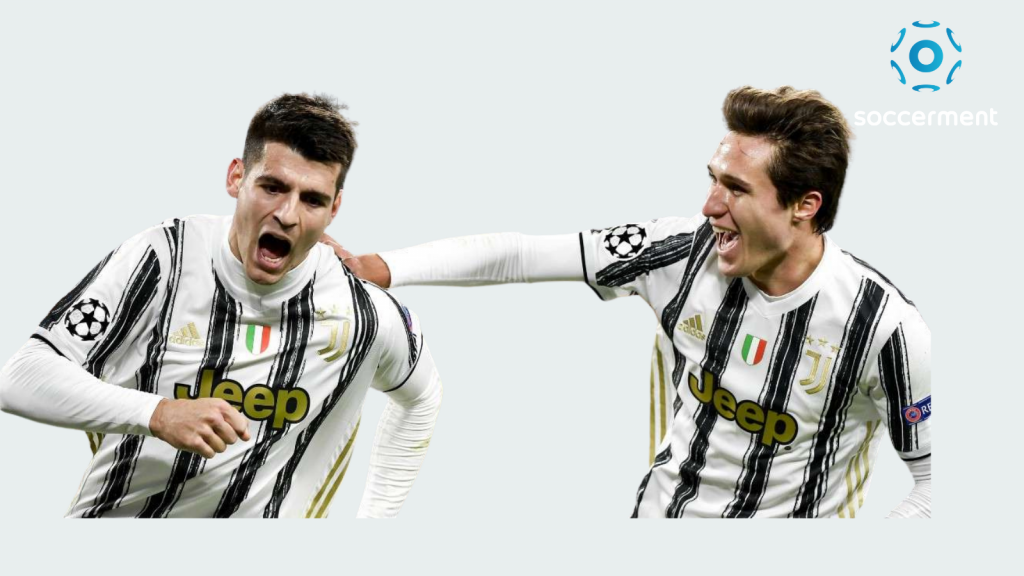
Álvaro Morata and Federico Chiesa have exchanged 0.25 xG P90 between themselves (0.33 goals P90), of which more than two-thirds (0.17 xG P90) went from Chiesa to Morata. This is quite intuitive as in Pirlo’s Juventus Chiesa was often the winger who created numerical superiority, with 2.1 successful dribbles per match (2.0 in 2020/21, against an average of 1.6) and 1.7 chances created P90 (1.8 in 2020/21). Morata meanwhile, who combines physical (190cm and 84kg) and technical skills (above-average goal conversion rate of 15.8%), was usually the main striker.
9) Sørloth-Nkunku
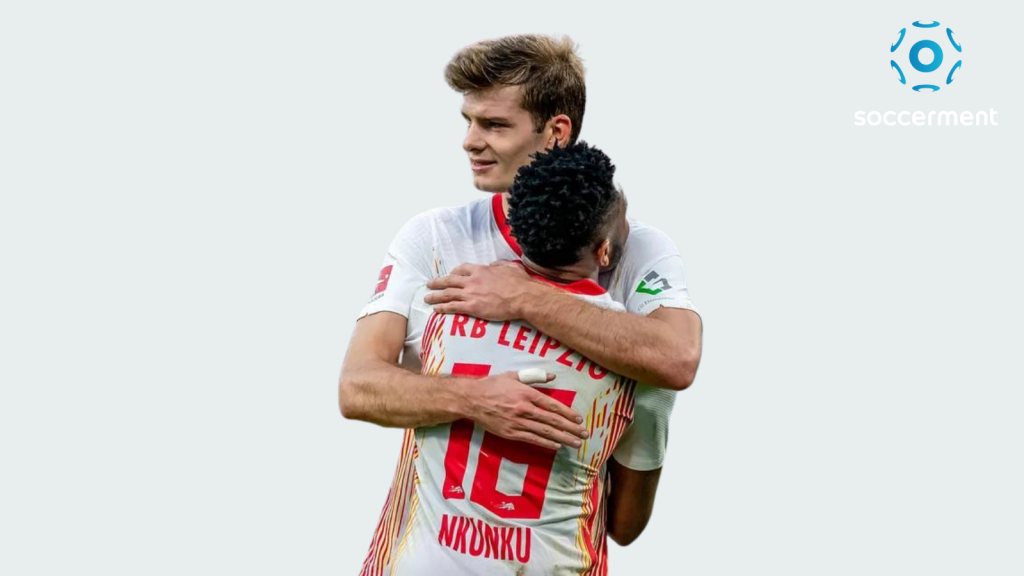
Last season, this RB Leipzig duo created 0.23 xG P90 and registered a very high overperformance with respect to xG of 154%. The relationship between the two is slightly unbalanced, with 0.15 of their xG P90 coming from Christopher Nkunku’s passes to Alexander Sørloth.
Nkunku’s characteristics fit well with a forward like Sørloth. The Frenchman’s creativity (2.67 chances created P90, 3.38 last season) allows him to effectively dialogue with the physically imposing Sørloth (195cm and 90kg) who has incredible heading ability (0.13 headed goals P90, average 0.07).
“Your last three assists have been for Alexander Sørloth, and he recently set up a goal for you too. Why is it working so well between the two of you?
Nkunku: “There’s always a relationship between the attacker and the players around the attacker like myself. Alex has a good footballing brain. He’s good at finding the space. We’ve been able to develop a good relationship thanks to his strengths in that area. We have to keep pushing in order to improve. I hope we continue in the same way.“
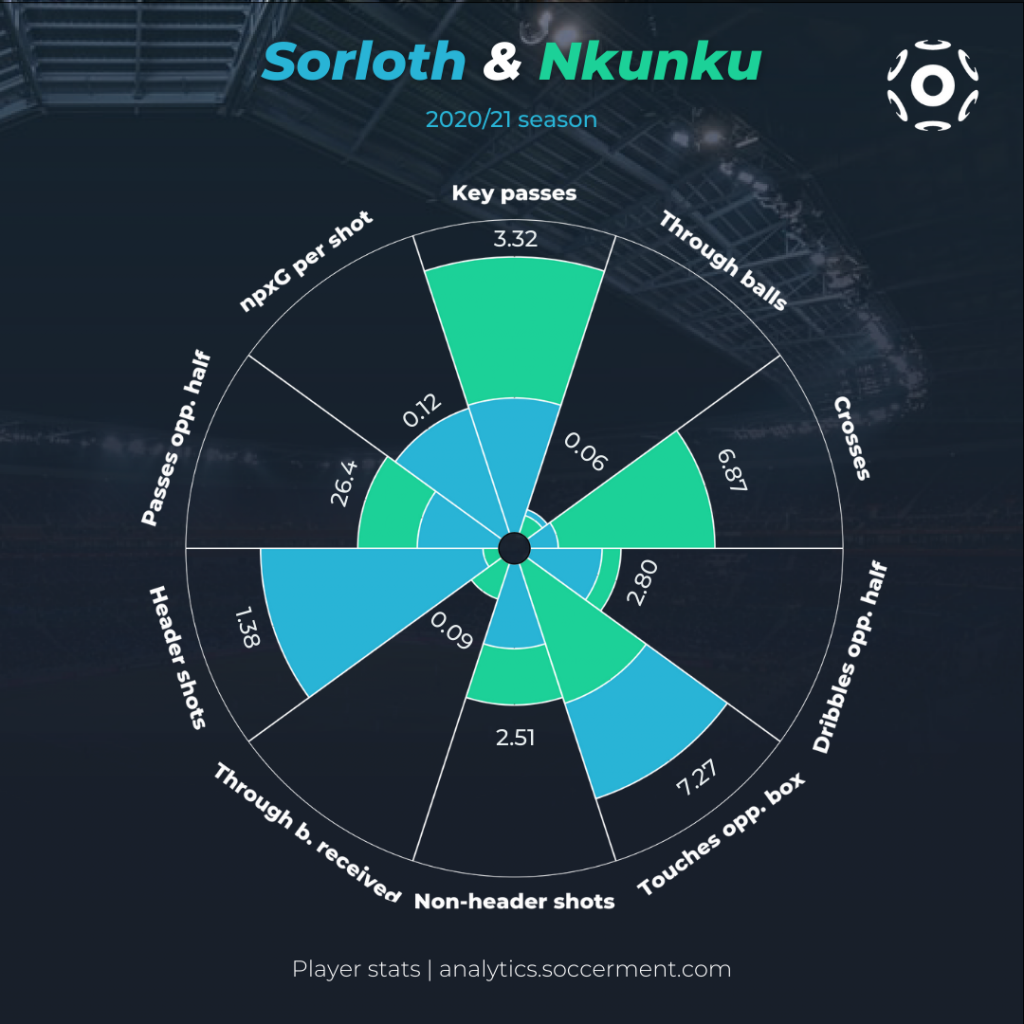
10) Kramaric-Bebou
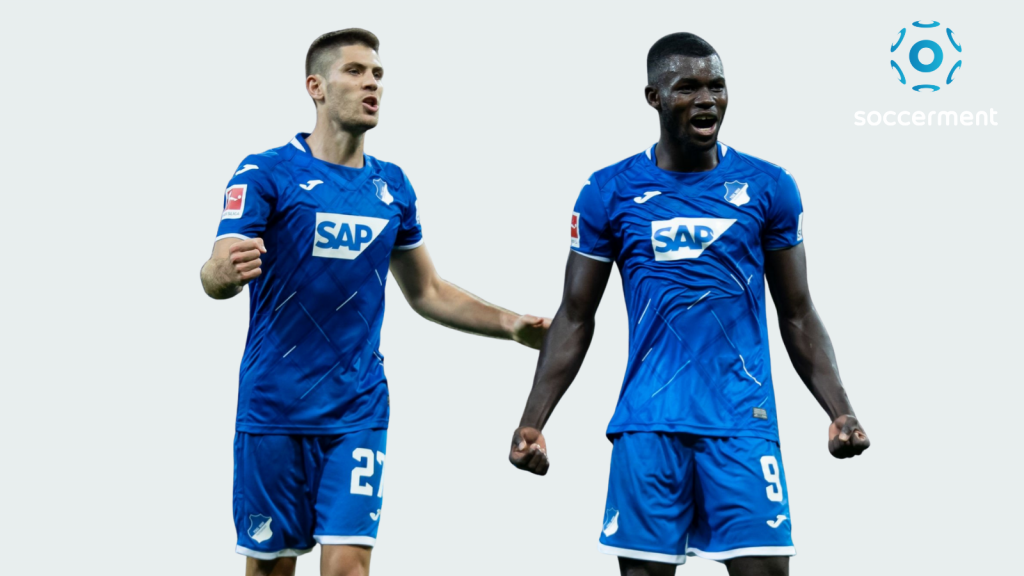
The two top scorers of Sebastian Hoeneß’s Hoffenheim have achieved 0.22 xG P90 (0.34 goals P90), with 59.7% of the xG (0.13) P90 going from Bebou to Kramaric. Last season, they were either deployed as forwards in a 3-4-1-2 formation, or with Kramaric as a second striker behind Bebou in a 4-2-3-1.
The two forwards seem to have a complementary set of skills: Bebou is a talented dribbler (2.4 successful dribbles P90, 1.8 in 2020/21), while Kramaric is a good creator (0.16 through balls P90, 0.19 last season). In addition, they both show above-average finishing ability (44.8% shot accuracy for Kramaric, 42.4% for Bebou).
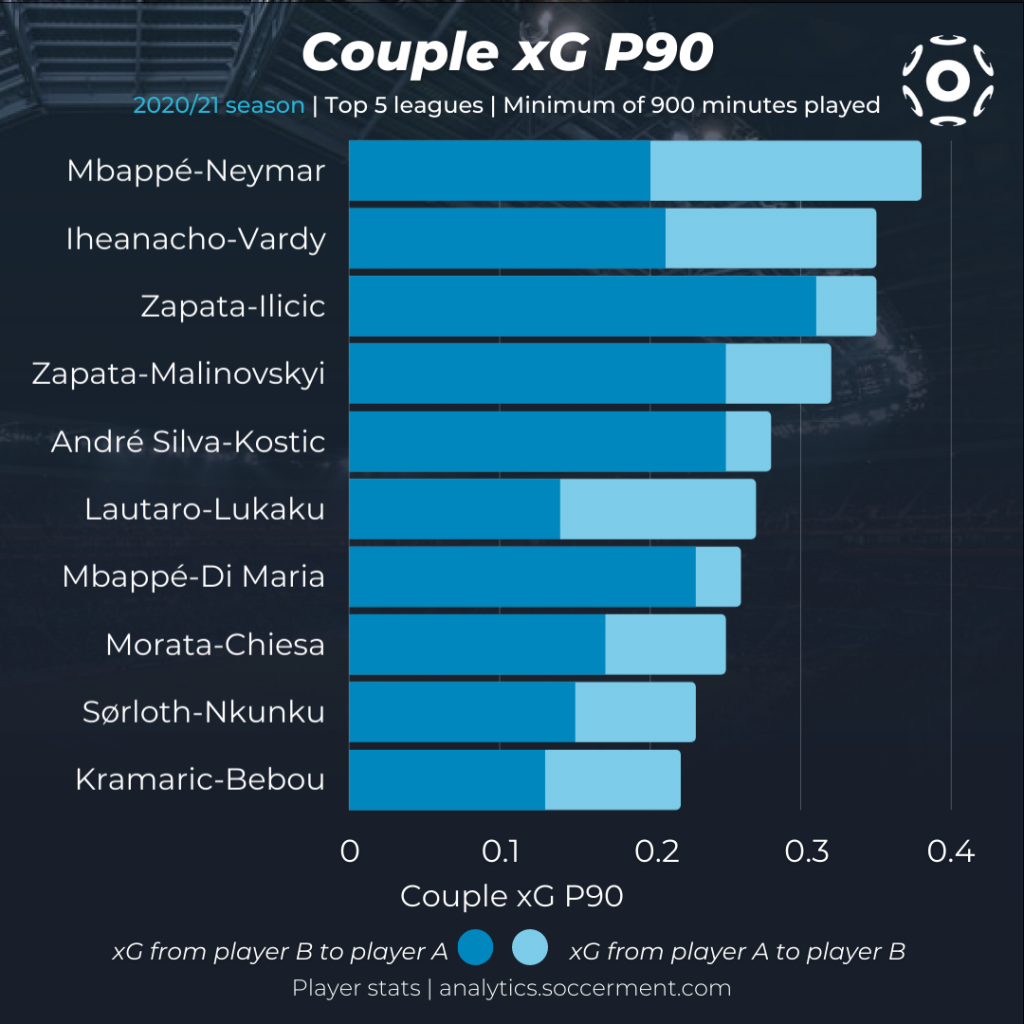
Most prolific pairs
The podium of highest scoring pairs features the aforementioned duos of Lewandowski-Müller and Kane-Son, who share the top spot with 0.42 goals P90 each. They are closely followed Zapata-Malinovskyi who score an average of 0.40 goals P90. This is the complete top 10:
- Lewandowski-Müller: 0.42 goals P90, (0.22 xG P90)
- Kane-Son: 0.42 goals P90, (0.21 xG P90)
- Zapata-Malinovskyi: 0.40 goals P90, (0.32 xG P90)
- Antonio-Lingard: 0.37 goals P90, (0.07 xG P90)
- Haaland-Sancho: 0.37 goals P90, (0.20 xG P90)
- Sørloth-Nkunku: 0.36 goals P90, (0.23 xG P90)
- André Silva-Kostic: 0.36 goals P90, (0.28 xG P90)
- Sergio Canales-Joaquín: 0.35 goals P90, (0.08 xG P90)
- Kramaric-Bebou: 0.34 goals P90, (0.22 xG P90)
- Ben Yedder-Volland: 0.33 goals P90, (0.22 xG P90)
Unsurprisingly, all pairs present outperform xG, but a few names particularly standout, let’s have a look at the best outperformers of xG.
Performance vs xG
Outperforming pairs: New names and historic outperformers
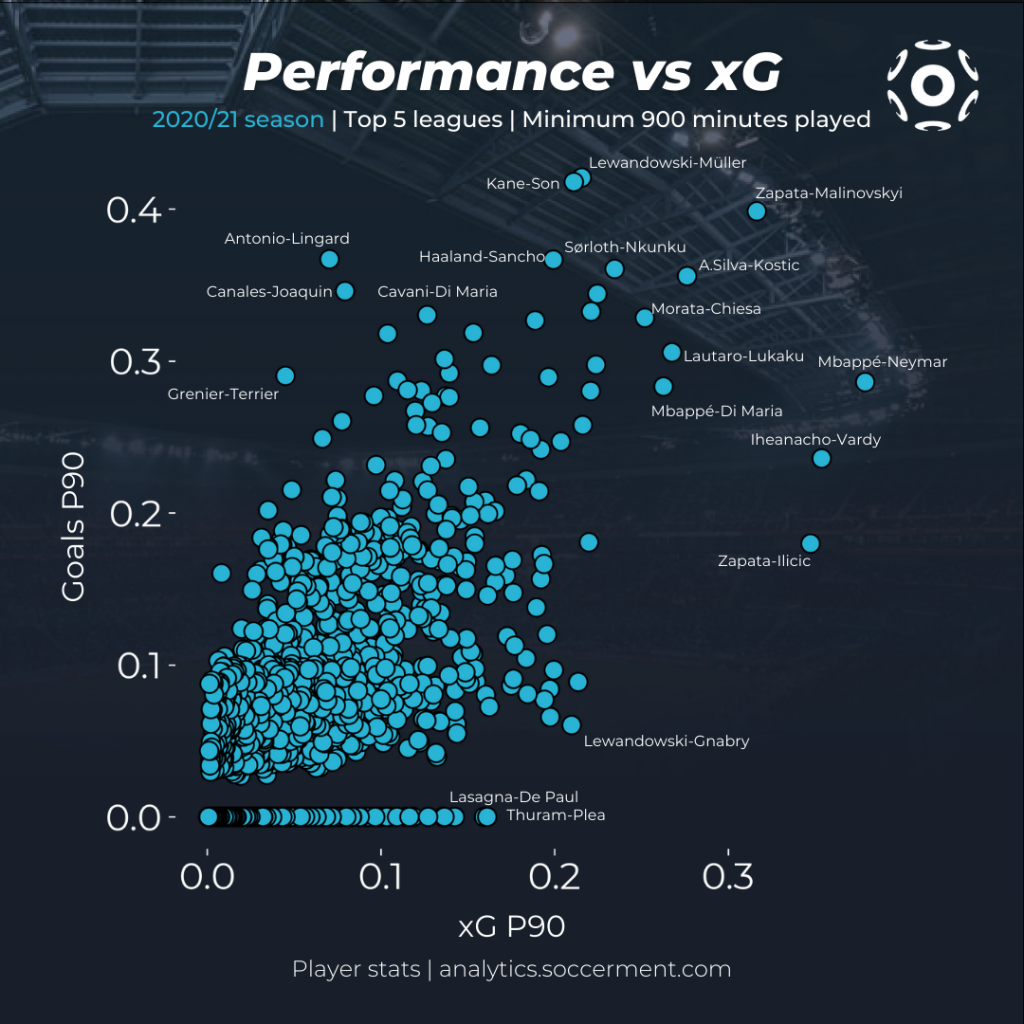
The pair that has outperformed expected goals the most on a P90 basis is Michail Antonio and Jesse Lingard, thanks to 0.37 goals P90 from just 0.07 xG P90. Lingard’s impact upon his arrival at West Ham has been impressive. He managed to score and provide vital goals and assists in the club’s push for European football. In 2nd place we find a pair of two very technical players: Sergio Canales (a hidden gem on the transfer market) and Joaquín (0.35 goals P90 from 0.08 xG P90). To complete the podium, we have the Rennes duo Clément Grenier and Martin Terrier, who have scored 0.29 goals P90 from just 0.04 xG P90.
[ec_store modelnumber=”REA003-EEN-2107″]Other very significant outperforming pairs were: Kane-Son (0.4 goals P90 from 0.2 xG P90), Lewandowski-Müller (0.42 goals P90 from 0.22 xG P90), Cavani-Rashford (0.33 goals P90 from 0.13 xG P90) and Haaland-Sancho (0.35 goals P90 from 0.19 xG P90).
A closer look at Kane and Son’s performance vs xG
Harry Kane isn’t new to outperforming xG, in fact, since the 2014/15 EPL season, he has always outperformed expected goals. The chemistry of his partnership with Son Heung-Min is clear for all to see, and it comes as no surprise that the data shows that they have created numerous chances for each other.
In Tottenham’s usual 4-2-3-1, Kane starts up top with Son occupying the left wing. Kane acts as a focal point while also dropping deep to facilitate build-up and combine with his teammates. Son, who is exceptional at making runs in behind the opposition defence, utilizes the space freed by Kane to run in behind, often assisted by Kane himself. In front of goal they are both lethal finishers and can make the most of the chances they get as proven last season under José Mourinho.
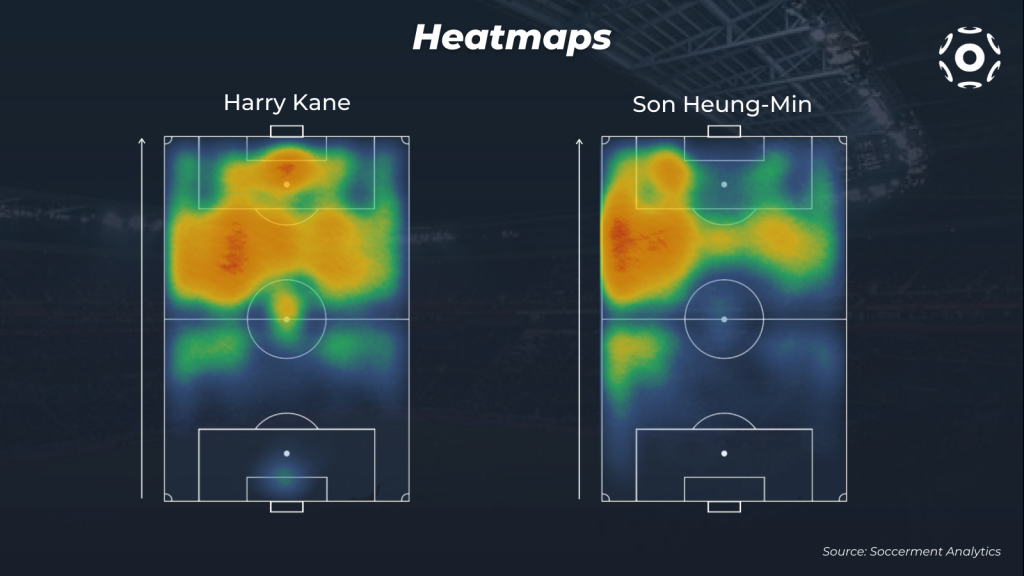
The Korean has made the most of the chances made for him by his teammates and confirmed himself as one of the best and most steady outperformers of xG: in the last four seasons he has scored 52 goals from 39.9 xG (performance vs xG of 132%), while for the 2020/21 season his out performance reaches a staggering 158% (17 goals from 10.77 xG). The Korean’s finishing skills also helped Kane top the assist charts in the last season. Loanee Gareth Bale also had a remarkable season for Spurs, outperforming xG thanks to 11 goals from just 6.01 xG. This makes him by far the player who outperformed xG the most on a P90 basis in last season.
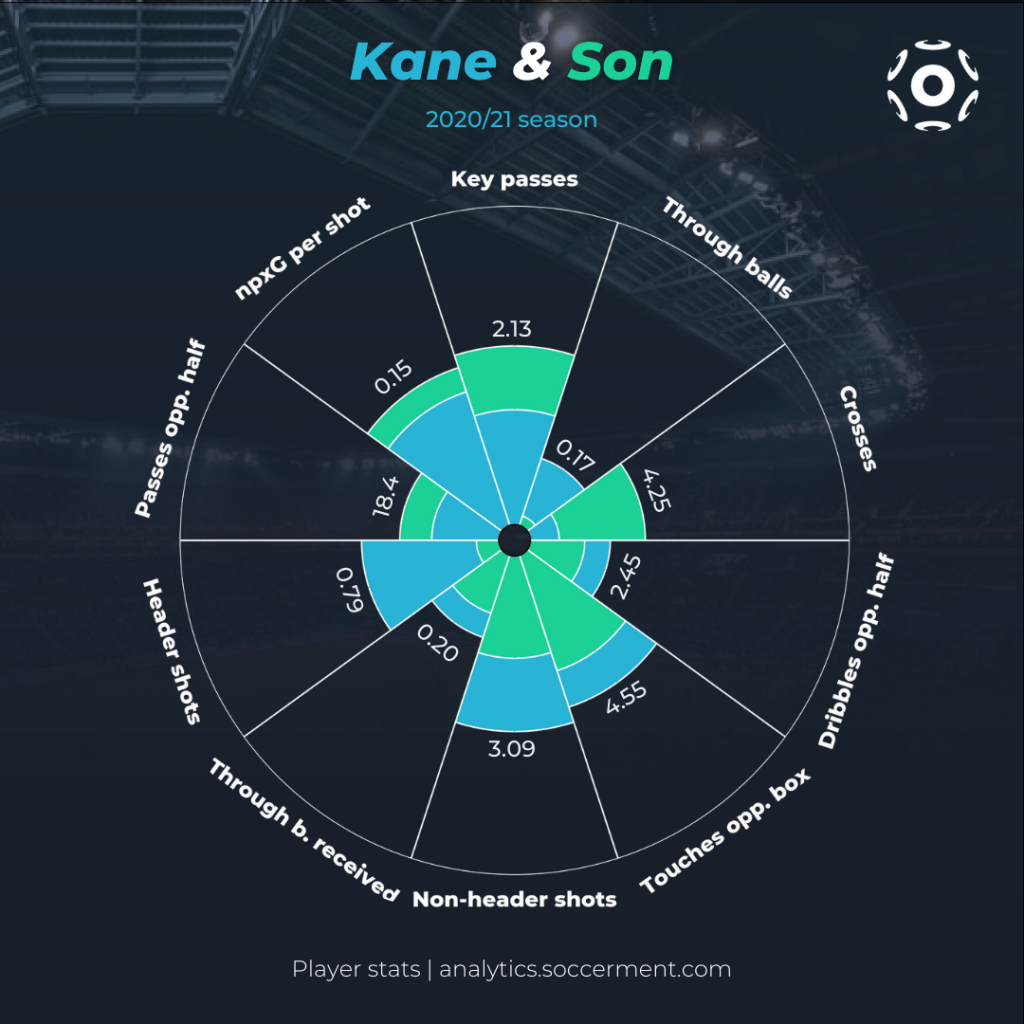
So, given the possible departure of the England captain to Manchester City, he could find new partners in Manchester: Riyad Mahrez, Phil Foden and Ferran Torres tend to outperform xG, while England teammate Raheem Sterling has a tendency to perform in line with xG or slightly underperform.
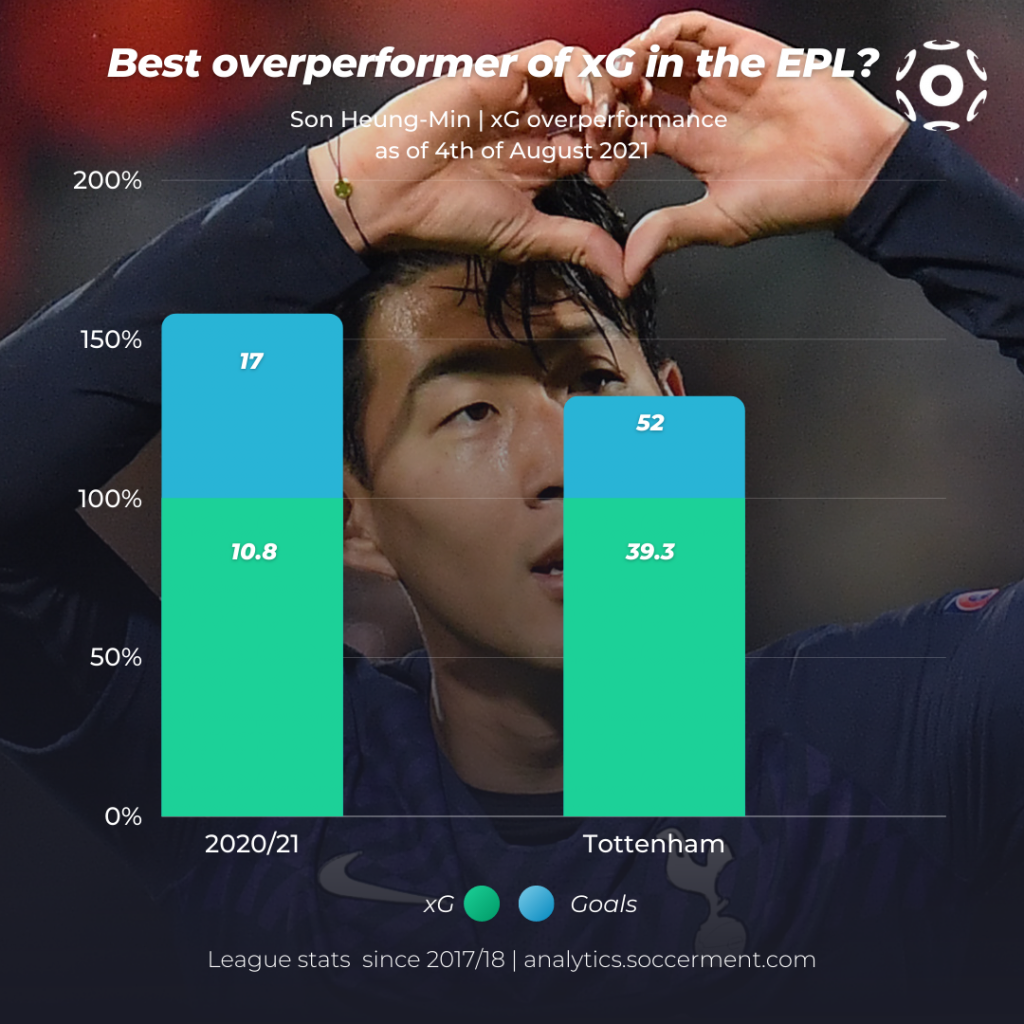
Underperforming pairs
The most underperforming pairs (in terms of goals P90 minus xG p90) are: Zapata-Ilicic (0.18 goals P90 from 0.35 xG P90), Marcus Thuram-Alassane Pléa (0 goals from 0.16 xG P90), Kevin Lasagna-Rodrigo De Paul (0 goals from 0.16 xG P90) and, perhaps surprisingly, Lewandowski-Gnabry (0.06 goals P90 from 0.21 xG P90).
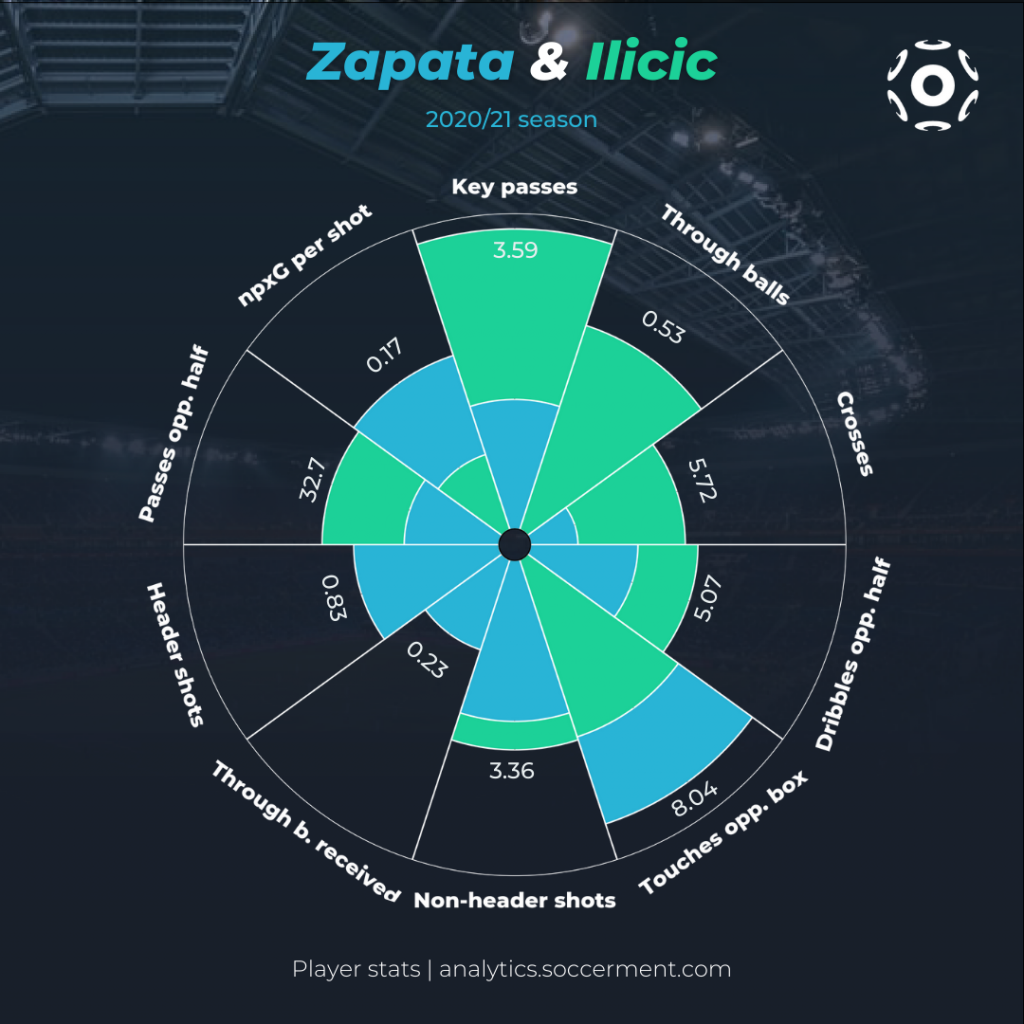
Of the top pairs, the most significant underperformers were: Iheanacho-Vardy (0.24 goals P90 from 0.35 xG P90), the aforementioned Lewandowski-Gnabry and Cristiano Ronaldo-Kulusevski (0 goals from 0.14 xG P90). With a total of 2.43 xG the pair from Juventus is the one that has produced the most xG without finding the back of the net in the 2020/21 season in Europe’s top 5 leagues. Given the level of the two players, we expect them to soon turn this underperformance around in the upcoming season.
For any comment, request or query, please write us to research@soccerment.com.

